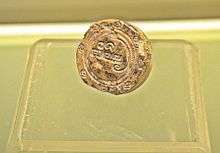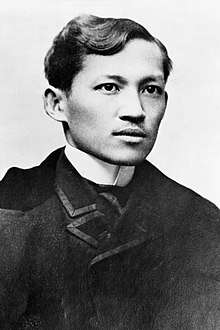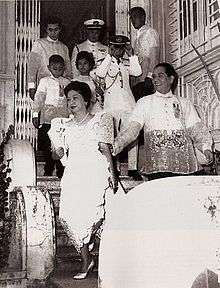History of the Philippines
The history of the Philippines is believed to have begun with the arrival of the first humans[1][2][3] using rafts or boats at least 67,000 years ago as the 2007 discovery of Callao Man suggested.[4] Negrito groups were the first inhabitants to settle in prehistoric Philippines. After that, groups of Austronesians later migrated to the islands.
Part of a series on the |
|---|
| History of the Philippines |
 |
|
Prehistory (pre–900) Paleolithic age
Events/Artifacts
|
|
Archaic epoch (900–1565) Historically documented city-states/polities
(by geography from North to South)
Legendary
Events/Artifacts
|
|
Colonial period (1565–1946) Spanish era
|
|
Post-colonial period (1946–1986)
|
|
Contemporary history (1986–present)
|
|
By topic
|
| Timeline |
| Archaeology |
|
|
| Part of a series on the |
| Culture of the Philippines |
|---|
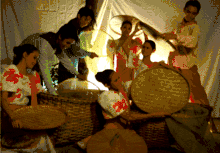 |
|
| People |
| Languages |
| Traditions |
|
Mythology and folklore
|
| Cuisine |
| Festivals |
| Religion |
| Art |
| Literature |
|
Music and performing arts
|
|
Media
|
|
Sport
|
|
Monuments
|
|
Scholars generally believe that these social groups eventually developed into various settlements or polities with varying degrees of economic specialization, social stratification, and political organization.[5] Some of these settlements (mostly those located on major river deltas) achieved such a scale of social complexity that some scholars believe they should be considered early states.[6] This includes the predecessors of modern-day population centers such as Maynila, Tondo, Pangasinan, Cebu, Panay, Bohol, Butuan, Cotabato, Lanao, and Sulu[2] as well as some polities, such as Ma-i, whose possible location are still the subject of debate among scholars.[7]
These polities were either influenced by the Hindu-Buddhist[8] Indian religion, language, culture, literature and philosophy from India through many campaigns from India including the South-East Asia campaign of Rajendra Chola I,[9] Islam from Arabia or were Sinified tributary states allied to China. These small maritime states flourished from the 1st millennium.[10][11] These kingdoms traded with what are now called China, India, Japan, Thailand, Vietnam, and Indonesia.[12] The remainder of the settlements were independent barangays allied with one of the larger states. These small states alternated from between being part of or being influenced by larger Asian empires like the Ming Dynasty, Majapahit and Brunei or rebelling and waging war against them.
The first recorded visit by Europeans is the arrival of Ferdinand Magellan. He sighted Samar Island on March 16, 1521 and landed the next day on Homonhon Island, now part of Guiuan, Eastern Samar.[13] Spanish colonization began with the arrival of Miguel López de Legazpi's expedition on February 13, 1565 from Mexico. He established the first permanent settlement in Cebu.[14] Much of the archipelago came under Spanish rule, creating the first unified political structure known as the Philippines. Spanish colonial rule saw the introduction of Christianity, the code of law and the oldest modern university in Asia. The Philippines was ruled under the Mexico-based Viceroyalty of New Spain. After which, the colony was directly governed by Spain.
Spanish rule ended in 1898 with Spain's defeat in the Spanish–American War. The Philippines then became a territory of the United States. U.S forces suppressed a Philippine Revolution led by Emilio Aguinaldo. The United States established the Insular Government to rule the Philippines. In 1907, the elected Philippine Assembly was set up with popular elections. The U.S. promised independence in the Jones Act.[15] The Philippine Commonwealth was established in 1935, as a 10-year interim step prior to full independence. However, in 1942 during World War II, Japan occupied the Philippines. The U.S. military overpowered the Japanese in 1945. The Treaty of Manila in 1946 established an independent Philippine Republic.
Timeline
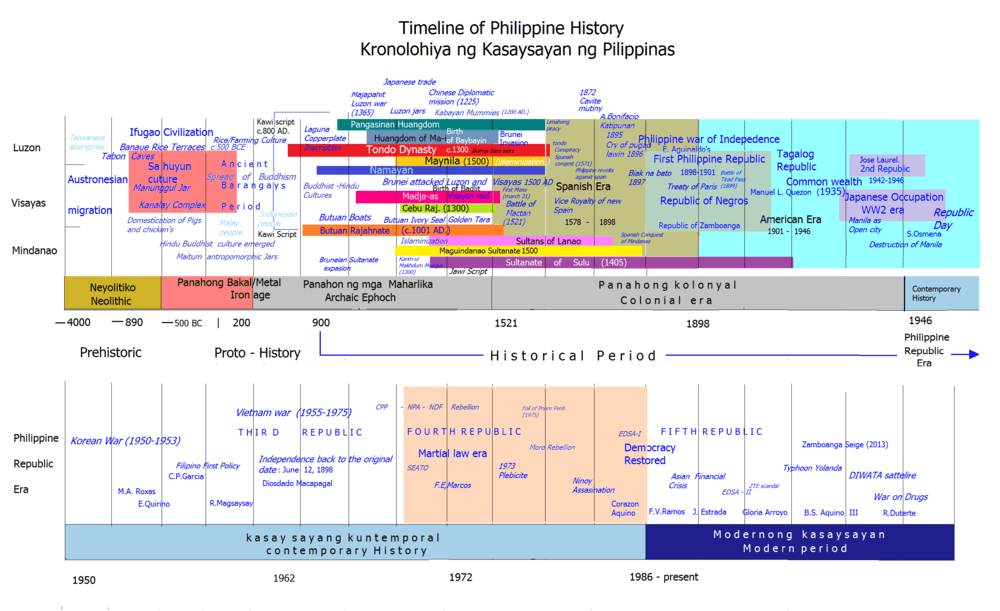
Prehistory
Discovery in 2018 of stone tools and fossils of butchered animal remains in Rizal, Kalinga has pushed back evidence of early hominins in the country to as early as 709,000 years.[16] Still, the earliest archeological evidence for humans in the archipelago is the 67,000-year-old Callao Man of Cagayan and the Angono Petroglyphs in Rizal, both of whom appear to suggest the presence of human settlement prior to the arrival of the Negritos and Austronesian speaking people.[17][18][19][20][21] Continued excavations in Callao Cave revealed 12 bones from three hominin individuals identified as a new species named Homo luzonensis.[22]
There are several opposing theories regarding the origins of ancient Filipinos. F. Landa Jocano theorizes that the ancestors of the Filipinos evolved locally. Wilhelm Solheim's Island Origin Theory[23] postulates that the peopling of the archipelago transpired via trade networks originating in the Sundaland area around 48,000 to 5000 BC rather than by wide-scale migration. The Austronesian Expansion Theory states that Malayo-Polynesians coming from Taiwan began migrating to the Philippines around 4000 BC, displacing earlier arrivals.[24][25]
The Negritos were early settlers, but their appearance in the Philippines has not been reliably dated.[26] They were followed by speakers of the Malayo-Polynesian languages, a branch of the Austronesian language family, who began to arrive in successive waves beginning about 4000 BC, displacing the earlier arrivals.[27][28] Before the expansion out of Taiwan, archaeological, linguistic and genetic evidence had linked Austronesian speakers in Insular Southeast Asia to cultures such as the Hemudu, its successor the Liangzhu[29][30] and Dapenkeng in Neolithic China.[31][32][33][34][35] During this neolithic period, a "jade culture" is said to have existed as evidenced by tens of thousands of exquisitely crafted jade artifacts found in the Philippines dated to 2000 BC.[36][37] The jade is said to have originated nearby in Taiwan and is also found in many other areas in insular and mainland Southeast Asia. These artifacts are said to be evidence of long range communication between prehistoric Southeast Asian societies.[38]
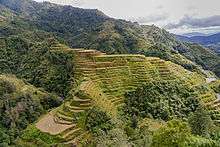
By 1000 BC, the inhabitants of the Philippine archipelago had developed into four distinct kinds of peoples: tribal groups, such as the Aetas, Hanunoo, Ilongots and the Mangyan who depended on hunter-gathering and were concentrated in forests; warrior societies, such as the Isneg and Kalinga who practiced social ranking and ritualized warfare and roamed the plains; the petty plutocracy of the Ifugao Cordillera Highlanders, who occupied the mountain ranges of Luzon; and the harbor principalities of the estuarine civilizations that grew along rivers and seashores while participating in trans-island maritime trade.[39] It was also during the first millennium BC that early metallurgy was said to have reached the archipelagos of maritime Southeast Asia via trade with India[40][41]
Around 300–700 AD, the seafaring peoples of the islands traveling in balangays began to trade with the Indianized kingdoms in the Malay Archipelago and the nearby East Asian principalities, adopting influences from both Buddhism and Hinduism.[42]
The Jade culture
Existence of a "Jade culture" in the Philippines is evidenced by tens of thousands of exquisitely crafted jade artifacts found at a site in Batangas province.[36][37]
Jade artifacts are made from white and green nephrite and dating as far back as 2000–1500 BC, have been discovered at a number of archeological excavations in the Philippines since the 1930s. The artifacts have been both tools like adzes[43] and chisels, and ornaments such as lingling-o earrings, bracelets and beads.
Nephrite, otherwise known as Jade, is a mineral widely used throughout Asia as ornaments or for decorative purposes. The oldest jade artefacts in Asia (6000 BC) were found in China where they were used as the primary hardstone of Chinese sculpturing. In 3000 BC, jade production in the Hongsan and Liangzhu cultures of China reached its peak. During this period, the knowledge of jade craftsmanship spread across the sea to Taiwan and eventually to the Philippines. The artefacts discovered in several sites in the Philippines were made from nephrite. Nephrite excavated in the Philippines were of two types: white nephrite and green nephrite.[44]
The Sa Huỳnh culture
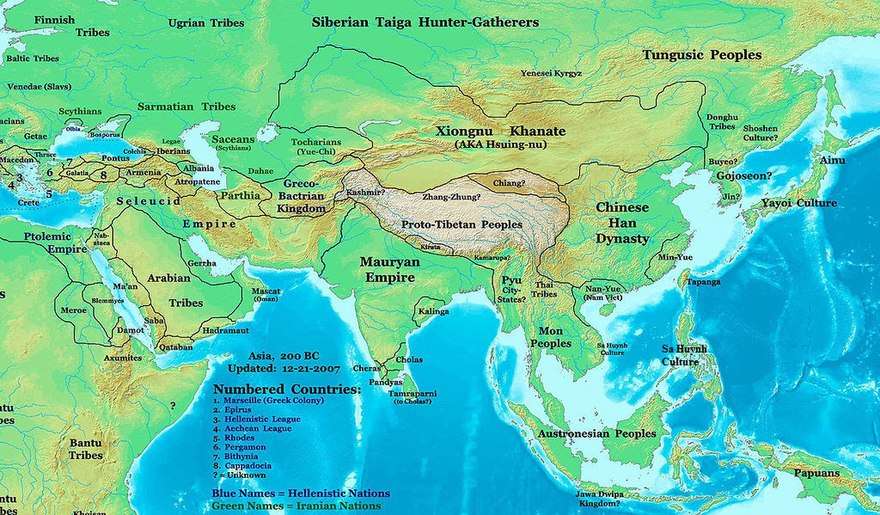
The Sa Huỳnh culture centred on present-day Vietnam, showed evidence of an extensive trade network. Sa Huỳnh beads were made from glass, carnelian, agate, olivine, zircon, gold and garnet; most of these materials were not local to the region, and were most likely imported. Han dynasty-style bronze mirrors were also found in Sa Huỳnh sites.
Conversely, Sa Huỳnh produced ear ornaments have been found in archaeological sites in Central Thailand, Taiwan (Orchid Island), and in the Philippines, in the Palawan, Tabon Caves. One of the great examples is the Kalanay Cave in Masbate; the artefacts on the site in one of the "Sa Huỳnh-Kalanay" pottery complex sites were dated 400BC–1500 AD. The Maitum anthropomorphic pottery in the Sarangani Province of southern Mindanao is c. 200 AD.[45][46]
Timeline of Iron Age

- Dates are approximate, consult particular article for details
- Prehistoric (or Proto-historic) Iron Age Historic Iron Age
Pre-colonial period (900 AD to 1565) - Indianised polities
.svg.png)
Initial recorded history
During the period of the south Indian Pallava dynasty and the north Indian Gupta Empire, Indian culture spread to Southeast Asia and the Philippines which led to the establishment of Indianized kingdoms.[47][48]
The date inscribed in the oldest Philippine document found so far, the Laguna Copperplate Inscription, is 900 AD. From the details of the document, written in Kawi script, the bearer of a debt, Namwaran, along with his children Lady Angkatan and Bukah, are cleared of a debt by the ruler of Tondo. It is the earliest document that shows the use of mathematics in precolonial Philippine societies. A standard system of weights and measures is demonstrated by the use of precise measurement for gold, and familiarity with rudimentary astronomy is shown by fixing the precise day within the month in relation to the phases of the moon.[49] From the various Sanskrit terms and titles seen in the document, the culture and society of Manila Bay was that of a Hindu–Old Malay amalgamation, similar to the cultures of Java, Peninsular Malaysia and Sumatra at the time.
There are no other significant documents from this period of pre-Hispanic Philippine society and culture until the Doctrina Christiana of the late 16th century, written at the start of the Spanish period in both native Baybayin script and Spanish. Other artifacts with Kawi script and baybayin were found, such as an Ivory seal from Butuan dated to the early 11th century and the Calatagan pot with baybayin inscription, dated to the 13th century.
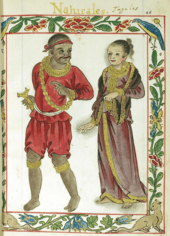
In the years leading up to 1000, there were already several maritime societies existing in the islands but there was no unifying political state encompassing the entire Philippine archipelago. Instead, the region was dotted by numerous semi-autonomous barangays (settlements ranging in size from villages to city-states) under the sovereignty of competing thalassocracies ruled by datus, wangs, rajahs, sultans or lakans.[50] or by upland agricultural societies ruled by "petty plutocrats". A number of states existed alongside the highland societies of the Ifugao and Mangyan.[51][52] These included:
- the Kingdom of Maynila
- the Kingdom of Taytay in Palawan (mentioned by Antonio Pigafetta to be where they resupplied when the remaining ships escaped Cebu after Magellan was slain)
- the Chieftaincy of Coron Island ruled by fierce warriors called Tagbanua as reported by Spanish missionaries mentioned by Nilo S. Ocampo,[53]
- the Namayan
- the Kingdom of Tondo
- the Sinitic wangdom of Pangasinan
- the nation of Ma-i
- the Kedatuans of Madja-as and Dapitan
- the Indianized rajahnates of Butuan and Cebu
- the sultanates of Maguindanao, Lanao and Sulu
Some of these regions were part of the Malayan empires of Srivijaya, Majapahit and Brunei.[54][55][56]
The Polity of Tondo
Since at least the year 900, this thalassocracy centered in Manila Bay flourished via an active trade with Chinese, Japanese, Malays, and various other peoples in Asia. Tondo thrived as the capital and the seat of power of this ancient kingdom, which was led by kings under the title "Lakan" which belongs to the caste of the Maharlika, who were the feudal warrior class in ancient Tagalog society. They ruled a large part of what is now known as Luzon from Ilocos to Bicol from possibly before 900 AD to 1571, becoming the largest pre-colonial state. The Spaniards called them Hidalgos.[57][58]
The people of Tondo had developed a culture which is predominantly Hindu and Buddhist, they were also good agriculturists, and lived through farming and aquaculture. During its existence, it grew to become one of the most prominent and wealthy kingdom states in pre-colonial Philippines due to heavy trade and connections with several neighboring nations such as China and Japan.

Due to its very good relations with Japan, the Japanese called Tondo as Luzon, even a famous Japanese merchant, Luzon Sukezaemon, went as far as to change his surname from Naya to Luzon. In 900 AD, the lord-minister Jayadewa presented a document of debt forgiveness to Lady Angkatan and her brother Bukah, the children of Namwaran. This is described in the Philippines' oldest known document, the Laguna Copperplate Inscription.[59]
Caboloan (Pangasinan)
Pangasinan or Feng-chia-hsi-lan in Chinese records, was a sovereign Prehispanic Philippine state, notable for having traded with the Kingdom of Ryukyu, Japan and was a tributary state to Ming Dynasty. The Chinese records of this kingdom began when the first tributary King (Wang in Chinese), Kamayin, sent an envoy offering gifts to the Chinese Emperor.[60] The state occupies the current province of Pangasinan. It was locally known the Luyag na Kaboloan (also spelled Caboloan), with Binalatongan as its capital, existed in the fertile Agno River valley. It flourished around the same period, the Srivijaya and Majapahit empires arose in Indonesia which had extended their influence to much of the Malay Archipelago. The Luyag na Kaboloan expanded the territory and influence of Pangasinan to what are now the neighboring provinces of Zambales, La Union, Tarlac, Benguet, Nueva Ecija, and Nueva Vizcaya. Pangasinan enjoyed full independence until the Spanish conquest.
In the sixteenth century Pangasinan was called the "Port of Japan" by the Spanish. The locals wore native apparel typical of other maritime Southeast Asian ethnic groups in addition to Japanese and Chinese silks. Even common people were clad in Chinese and Japanese cotton garments. They also blackened their teeth and were disgusted by the white teeth of foreigners, which were likened to that of animals. Also, used porcelain jars typical of Japanese and Chinese households. Japanese-style gunpowder weapons were also encountered in naval battles in the area.[1] In exchange for these goods, traders from all over Asia would come to trade primarily for gold and slaves, but also for deerskins, civet and other local products. Other than a notably more extensive trade network with Japan and China, they were culturally similar to other Luzon groups to the south.
According to historian Paul Kekai Manansala, the famed Ming admiral, Zheng He, attacked Luzon and destroyed Manila but an alliance of local kingdoms then repulsed his army and the conquest was forced back and limited to Pangasinan.[61] In northern Luzon, Caboloan (Pangasinan) (c. 1406–1576) sent emissaries to China in 1406–1411 as a tributary-state,[62] and it also traded with Japan.[63] People from Pangasinan were humble despite their immense power since when the Mongol Empire arose, according to Moroccan explorer, Ibn Battuta[64] a Warrior-Princess from Pangasinan (Cabaloan) named Urduja lead a nation and coalition that became a rival to the entire Mongol Empire. A priceless 3000 year old Platinum Ding (Exclusive Symbol of Imperial Power) has been recently unearthed in Luzon near Pangasinan.[65] This may be proof that the legend of Warrior Princess Urduja had legitimate precedence since it possessed a Ding with Imperial significance and rarity that it wielded immense moral and political power to rival even the legitimacy of Mongol Khans. However Caboloan showed their solidarity with the Anti-Mongol Ming Dynasty when they became Ming tributaries.[66]
The Nation of Ma-i

Around 1225, the nation of Ma-i, a Buddhist pre-Hispanic Philippine island-state centered in Mindoro,[67] flourished as an entrepôt, attracting traders and shipping from the Kingdom of Ryukyu to the Empire of Japan.[68] Chao Jukua, a customs inspector in Fukien province, China wrote the Zhufan Zhi ("Description of the Barbarous Peoples"[69]), which described trade with this pre-colonial state. Its people were noted for their honesty and trustworthiness in trade.[70]
The Kedatuan of Dapitan
Around the 11th century, a group of people from Northern Mindanao settled in the strait between mainland Bohol and the island of Panglao. Those people came from a nation in northern Mindanao called Lutao (probably the animist kingdom of what will soon be the Islamic Lanao). Those people established the Kedatuan of Dapitan in western Bohol because the true indigenous people of Bohol in the Anda peninsula and nearby areas were not open to them, forcing them to establish settlement in the western part of the island. The kedatuan was first built with hardwood on the soft seabed. It engaged it trade with nearby areas and some Chinese merchants. The Jesuit Alcina tells tales about a rich nation he called the 'Venice of the Visayas', pointing to the Kedatuan of Dapitan at that time. The Jesuit also tells of a Dapitan princess named Bugbung Hamusanum, whose beauty caused her suitor, Datu Sumangga of Leyte, to raid parts of southern China to win her hand. Their dynasty founded the Kedatuan of Dapitan.[71]
The Kedatuan of Madja-as
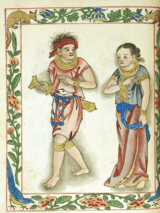

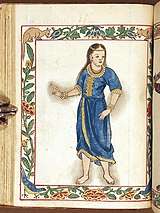
During the 11th century several exiled datus of the collapsing empire of Srivijaya[72] led by Datu Puti led a mass migration to the central islands of the Philippines, fleeing from Rajah Makatunao of the island of Borneo. Upon reaching the island of Panay and purchasing the island from Negrito chieftain Marikudo, they established a confederation of polities and named it the Kedatuan of Madja-as centered in Aklan and they settled the surrounding islands of the Visayas. Madja-as was founded on Panay island (named after the destroyed state of Pannai as well as populated by Pannai's descendants, Pannai was a constituent state of Srivijaya which was located in Sumatra and was home to a Hindu-Buddhist Monastic-Army that successfully defended the Strait of Malacca,[73] the world's busiest maritime choke-point,[74] which was a significant challenge to defend due to it being surrounded by the three most populous nations of the world back then, China, India and Indonesia. The people of Pannai policed the Strait against all odds for 727 years.) Upon their rebellion against an invading Chola Empire, the people of Madja-as, being loyalist warriors, conducted resistance movements against the Hindu and Islamic invaders that arrived from the west from their new home base in the Visayas islands.[75] This confederation reached its peak under Datu Padojinog. During his reign the confederations' hegemony extended over most of the islands of Visayas. Its people consistently made piratical attacks against Chinese imperial shipping.[76]
The Rajahnate of Cebu
The Rajahnate of Cebu was a pre-colonial state. It was founded by Sri Lumay otherwise known as Rajamuda Lumaya, a minor prince of the Hindu Chola dynasty which happened to occupy Sumatra-Indonesia. He was sent by the maharajah to establish a base for expeditionary forces to subdue the local kingdoms but he rebelled and established his own independent Rajahnate instead. This rajahnate warred against the 'magalos' (slave traders) of Maguindanao and had an alliance with the Rajahnate of Butuan and Indianized Kutai in South Borneo, before it was weakened by the insurrection of Datu Lapu-Lapu.[77]
The Rajahnate of Butuan
| Rajahnate of Butuan |
|---|
|
In the year 1011, Rajah Sri Bata Shaja, the monarch of the Indianized Rajahnate of Butuan, a maritime-state famous for its goldwork[78] sent a trade envoy under ambassador Likan-shieh to the Chinese Imperial Court demanding equal diplomatic status with other states.[79] The request being approved, it opened up direct commercial links with the Rajahnate of Butuan and the Chinese Empire thereby diminishing the monopoly on Chinese trade previously enjoyed by their rivals, Tondo and the Champa civilization. Evidence of the existence of this rajahnate is given by the Butuan Silver Paleograph. Butuan was so wealthy, the quantity of gold recently unearthed in Butuan surpassed that of the even more famous Srivijaya state even when most of the gold of the Butuan kingdom were already plundered by various invaders before modern times.[80]
Struggle against Majapahit
During the 1300s, the Javanese-centered Hindu empire of Majapahit briefly ruled over Luzon island and the Sulu archipelago as recorded in the epic poem Nagarakretagama, which stated that they had colonies in the Philippines at Saludong (Manila) and Solot (Sulu).[81] It even incorporated the Butuan and Cebu Rajahanates' Bornean ally, Kutai. But they failed to take hold of the Visayas islands, which was populated by Srivijayan loyalists who were waging incessant guerrilla warfare against them. Eventually, the kingdoms of Luzon regained independence from Majapahit after the Battle of Manila (1365) and Sulu also reestablished independence, and in vengeance, assaulted the Majapahit province of Poni (Brunei) before a fleet from the capital drove them out.[82] The subsequent start of the Islamic era ushered the slow death of Majapahit as its provinces eventually seceded and became independent sultanates. With the upsurge of Islam, the remnants of Hindu Majapahit eventually fled to the island of Bali.[83]
The Sultanate of Sulu

In 1380, Karim ul' Makdum and Shari'ful Hashem Syed Abu Bakr, an Arab trader born in Johore, arrived in Sulu from Malacca and established the Sultanate of Sulu by converting its previous ruler, the Hindu king, Rajah Baguinda, to Islam and then marrying his daughter. This sultanate eventually gained great wealth due to its diving for fine pearls.[84]
The Sultanate of Maguindanao
The Sultanate of Maguindanao rose to prominence at the end of the 15th century, Shariff Mohammed Kabungsuwan of Johor introduced Islam in the island of Mindanao and he subsequently married Paramisuli, an Iranun princess from Mindanao, and established the Sultanate of Maguindanao.[85]
It ruled most parts of Mindanao and continued to exist prior to the Spanish colonization until the 19th century. The Sultanate also traded and maintained good relations with the Chinese, Dutch, and the British.[86][87]
The Sultanate of Lanao
The Sultanates of Lanao in Mindanao, Philippines were founded in the 16th century through the influence of Shariff Kabungsuan, who was enthroned as first Sultan of Maguindanao in 1520. Islam was introduced to the area by Muslim missionaries and traders from the Middle East, Indian and Malay regions who propagated Islam to Sulu and Maguindanao. Unlike in Sulu and Maguindanao, the Sultanate system in Lanao was uniquely decentralized. The area was divided into Four Principalities of Lanao or the Pat a Pangampong a Ranao which are composed of a number of royal houses (Sapolo ago Nem a Panoroganan or The Sixteen (16) Royal Houses) with specific territorial jurisdictions within mainland Mindanao. This decentralized structure of royal power in Lanao was adopted by the founders, and maintained up to the present day, in recognition of the shared power and prestige of the ruling clans in the area, emphasizing the values of unity of the nation (kaiisaisa o bangsa), patronage (kaseselai) and fraternity (kapapagaria). By the 16th century, Islam had spread to other parts of the Visayas and Luzon.
The Bruneian Empire and the expansion of Islam
Upon the secession of Poni (Brunei) from the Majapahit Empire, they imported the Arab Emir from Mecca, Sharif Ali, and became an independent Sultanate. During the reign of his descendant, Sultan Bolkiah, in 1485 to 1521, the recently Islamized Bruneian Empire decided to break the Dynasty of Tondo's monopoly in the China trade by attacking Tondo and defeating Rajah Gambang and then establishing the State of Selurong (Kingdom of Maynila) as a Bruneian satellite-state and placing his descendants on the throne of Maynila.[3][88] A new dynasty under the Islamized Rajah Salalila[89] was also established to challenge the House of Lakandula in Tondo.[90] In addition to establishing the satellite state of Manila, Sultan Bolkiah also married Laila Mecana, the daughter of Sulu Sultan Amir Ul-Ombra to expand Brunei's influence in both Luzon and Mindanao. Furthermore, Islam was further strengthened by the arrival to the Philippines of traders and proselytizers from Malaysia and Indonesia.[91]
Concurrent with the spread of Islam in the Philippine archipelago, was the rise of the Lucoes who were the people of Luzon. They rose to prominence by establishing overseas communities all across Southeast Asia and participating in trading ventures, navigation expeditions and military campaigns in Burma, Malacca and East Timor[92][93][94] where they were employed as traders and mercenaries.[95][96][97] One prominent Luções was Regimo de Raja, who was a spice magnate and a Temenggung (Jawi: تمڠݢوڠ)[98] (Governor and Chief General) in Portuguese Malacca. He was also the head of an international armada which traded and protected commerce between the Indian Ocean, the Strait of Malacca, the South China Sea,[99] and the medieval maritime principalities of the Philippines.[100][101]
Around 1563 AD, at the closing stages of the precolonial era, the Kedatuan of Dapitan in Bohol achieved prominence and it was known to a later Spanish missionary, Alcina, as the "Venice of the Visayas", because it was a wealthy, wooden and floating city-state in the Visayas. However, this kedatuan was eventually attacked and destroyed by soldiers from the Sultanate of Ternate, a state made up of Muslim Moluccans. The survivors of the destruction, led by their datu, Pagbuaya, migrated to northern Mindanao and established a new Dapitan there. They then waged war against the Sultanate of Lanao and settled in the lands conquered from them. Eventually, in vengeance against the Muslims and Portuguese allied to the Ternateans, they aided the Spanish in the conquest of Muslim Manila and in the Spanish expeditions to capture Portuguese Ternate. There was also a simmering territorial conflict between the Polity of Tondo and the Bruneian vassal-state, the Islamic Rajahnate of Maynila, to which the ruler of Maynila, Rajah Matanda, sought military assistance against Tondo from his relatives at the Sultanate of Brunei.[102] The Hindu Rajahnates of Butuan and Cebu also endured slave raids from, and waged wars against the Sultanate of Maguindanao.[103] Simultaneous with these slave-raids, was the rebellion of Datu Lapu-Lapu of Mactan against Rajah Humabon of Cebu.[104] The sparse population and the multiple states competing over the limited territory and people of the islands simplified Spanish colonization by allowing its conquistadors to effectively employ a strategy of divide and conquer for rapid conquest.
Spanish settlement and rule (1565–1898)
Early Spanish expeditions and conquests
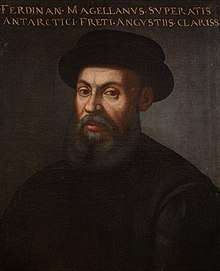
Parts of the Philippine Islands were known to Europeans before the 1521 Spanish expedition around the world led by Portuguese-born Spanish explorer Ferdinand Magellan (the Portuguese conquered Malacca City in 1511 and reached Maluku Islands in 1512 ). Magellan landed on the island called Homonhon, claiming the islands he saw for Spain, and naming them Islas de San Lázaro.[105] He established friendly relations with some of the local leaders especially with Rajah Humabon and converted some of them to Roman Catholicism.[105] In the Philippines, they explored many islands including the island of Mactan. However, Magellan was killed during the Battle of Mactan against the local datu, Lapu-Lapu.
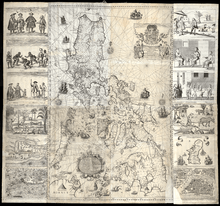
Over the next several decades, other Spanish expeditions were dispatched to the islands. In 1543, Ruy López de Villalobos led an expedition to the islands and Leyte and Samar Las Islas Filipinas in honor of Philip of Austria, the Prince of Asturias at the time.[106] Philip became Philip II of Spain on January 16, 1556, when his father, Charles I of Spain (who also reigned as Charles V, Holy Roman Emperor), abdicated the Spanish throne. The name was then extended to the entire archipelago later on in the Spanish era.

European colonization began in earnest when Spanish explorer Miguel López de Legazpi arrived from Mexico in 1565 and formed the first European settlements in Cebu. Beginning with just five ships and five hundred men accompanied by Augustinian monks, and further strengthened in 1567 by two hundred soldiers, he was able to repel the Portuguese and create the foundations for the colonization of the Archipelago. In 1571, the Spanish, their Latin-American recruits and their Filipino (Visayan) allies, commanded by able conquistadors such as Mexico-born Juan de Salcedo (who was in love with Tondo's princess, Kandarapa) attacked the Maynila, a vassal-state of the Brunei Sultanate and liberated plus incorporated the kingdom of Tondo as well as establishing Manila as the capital of the Spanish East Indies.[107][108]

Legazpi built a fort in Maynila and made overtures of friendship to Lakan Dula, Lakan of Tondo, who accepted. However, Maynila's former ruler, the Muslim rajah, Rajah Sulayman, who was a vassal to the Sultan of Brunei, refused to submit to Legazpi, but failed to get the support of Lakan Dula or of the Pampangan and Pangasinan settlements to the north. When Tarik Sulayman and a force of Kapampangan and Tagalog Muslim warriors attacked the Spaniards in the battle of Bangkusay, he was finally defeated and killed.
In 1578, the Castilian War erupted between the Christian Spaniards and Muslim Bruneians over control of the Philippine archipelago. On one side, the newly Christianized Non-Muslim Visayans of the Kedatuan of Madja-as and Rajahnate of Cebu, plus the Rajahnate of Butuan (which were from northern Mindanao), as well as the remnants of the Kedatuan of Dapitan had previously waged war against the Sultanate of Sulu, Sultanate of Maguindanao and Kingdom of Maynila, then joined the Spanish in the war against the Bruneian Empire and its allies, the Bruneian puppet-state of Maynila, Sulu which had dynastic links with Brunei as well as Maguindanao which was an ally of Sulu. The Spanish and its Visayan allies assaulted Brunei and seized its capital, Kota Batu. This was achieved as a result in part of the assistance rendered to them by two noblemen, Pengiran Seri Lela and Pengiran Seri Ratna. The former had traveled to Manila to offer Brunei as a tributary of Spain for help to recover the throne usurped by his brother, Saiful Rijal.[109] The Spanish agreed that if they succeeded in conquering Brunei, Pengiran Seri Lela would indeed become the Sultan, while Pengiran Seri Ratna would be the new Bendahara. In March 1578, the Spanish fleet, led by De Sande himself, acting as Capitán General, started their journey towards Brunei. The expedition consisted of 400 Spaniards and Mexicans, 1,500 Filipino natives and 300 Borneans.[110] The campaign was one of many, which also included action in Mindanao and Sulu.[111][112]
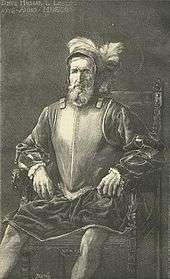
The Spanish succeeded in invading the capital on April 16, 1578, with the help of Pengiran Seri Lela and Pengiran Seri Ratna. Sultan Saiful Rijal and Paduka Seri Begawan Sultan Abdul Kahar were forced to flee to Meragang then to Jerudong. In Jerudong, they made plans to chase the conquering army away from Brunei. The Spanish suffered heavy losses due to a cholera or dysentery outbreak.[113][114] They were so weakened by the illness that they decided to abandon Brunei to return to Manila on June 26, 1578, after just 72 days. Before doing so, they burned the mosque, a high structure with a five-tier roof.[115]
Pengiran Seri Lela died in August–September 1578, probably from the same illness that had afflicted his Spanish allies, although there was suspicion he could have been poisoned by the ruling Sultan. Seri Lela's daughter, the Bruneian princess, left with the Spanish and went on to marry a Christian Tagalog, named Agustín de Legazpi of Tondo and had children in the Philippines.[116]
In 1587, Magat Salamat, one of the children of Lakan Dula, along with Lakan Dula's nephew and lords of the neighboring areas of Tondo, Pandacan, Marikina, Candaba, Navotas and Bulacan, were executed when the Tondo Conspiracy of 1587–1588 failed in which a planned grand alliance with the Japanese Christian-captain, Gayo, and Brunei's Sultan, would have restored the old aristocracy. Its failure resulted in the hanging of Agustín de Legaspi and the execution of Magat Salamat (the crown-prince of Tondo).[117] Thereafter, some of the conspirators were exiled to Guam or Guerrero, Mexico.
Spanish power was further consolidated after Miguel López de Legazpi's complete assimilation of Madja-as, his subjugation of Rajah Tupas, the Rajah of Cebu and Juan de Salcedo's conquest of the provinces of Zambales, La Union, Ilocos, the coast of Cagayan, and the ransacking of the Chinese warlord Limahong's pirate kingdom in Pangasinan.
The Spanish also invaded Northern Taiwan and Ternate in Indonesia, using Filipino warriors, before they were driven out by the Dutch.[118]
The Spanish and the Moros of the sultanates of Maguindanao, Lanao and Sulu also waged many wars over hundreds of years in the Spanish-Moro conflict, not until the 19th century did Spain succeed in defeating the Sulu Sultanate and taking Mindanao under nominal suzerainty.
The Spanish considered their war with the Muslims in Southeast Asia an extension of the Reconquista, a centuries-long campaign to retake and rechristianize the Spanish homeland which was invaded by the Muslims of the Umayyad Caliphate. The Spanish expeditions into the Philippines were also part of a larger Ibero-Islamic world conflict[119] that included a war against the Ottoman Caliphate which had just invaded former Christian lands in the Eastern Mediterranean and which had a center of operations in Southeast Asia at its nearby vassal, the Sultanate of Aceh.[120]
Spanish settlement during the 16th and 17th centuries
_by_Brambila.jpg)

The "Memoria de las Encomiendas en las Islas" of 1591, just twenty years after the conquest of Luzon, reveals a remarkable progress in the work of colonization and the spread of Christianity.[121] A cathedral was built in the city of Manila with an episcopal palace, Augustinian, Dominican and Franciscan monasteries and a Jesuit house. The king maintained a hospital for the Spanish settlers and there was another hospital for the natives run by the Franciscans. In order to defend the settlements the Spaniards established in the Philippines, a network of military fortresses called "Presidios" were constructed and officered by the Spaniards, and sentried by Latin-Americans and Filipinos, across the archipelago, to protect it from foreign nations such as the Portuguese, British and Dutch as well as raiding Muslims and Wokou.[122] The Manila garrison was composed of roughly four hundred Spanish soldiers and the area of Intramuros as well as its surroundings, were initially settled by 1200 Spanish families.[123] In Cebu City, at the Visayas, the settlement received a total of 2,100 soldier-settlers from New Spain.[124] At the immediate south of Manila, Mexicans were present at Ermita[125] and at Cavite[126][127][128] where they were stationed as sentries. In addition, men conscripted from Peru, were also sent to settle Zamboanga City in Mindanao, to wage war upon Muslim pirates.[129] There were also communities of Spanish-Mestizos that developed in Iloilo,[130] Negros[131] and Vigan.[132] Interactions between native Filipinos and immigrant Spaniards, Latin-Americans and their Spanish-Mestizo descendants eventually caused the formation of a new language, Chavacano, a creole of Mexican Spanish. Meanwhile, in the suburb of Tondo, there was a convent run by Franciscan friars and another by the Dominicans that offered Christian education to the Chinese converted to Christianity. The same report reveals that in and around Manila were collected 9,410 tributes, indicating a population of about 30,640 who were under the instruction of thirteen missionaries (ministers of doctrine), apart from the monks in monasteries. In the former province of Pampanga the population estimate was 74,700 and 28 missionaries. In Pangasinan 2,400 people with eight missionaries. In Cagayan and islands Babuyanes 96,000 people but no missionaries. In La Laguna 48,400 people with 27 missionaries. In Bicol and Camarines Catanduanes islands 86,640 people with fifteen missionaries. Based on the tribute counts, the total founding population of Spanish-Philippines was 667,612 people,[133] of which: 20,000 were Chinese migrant traders,[134] 16,500 were Latino soldier-colonists sent from Peru and Mexico,[135] 3,000 were Japanese residents,[136] and 600 were pure Spaniards from Europe,[137] there was also a large but unknown number of Indian Filipinos, the rest were Malays and Negritos. They were under the care of 140 missionaries, of which 79 were Augustinians, nine Dominicans and 42 Franciscans.[138] During the Spanish evacuation of Ternate, Indonesia, the 200 families of mixed Mexican-Filipino-Spanish and Moluccan-Portuguese descent who had ruled over the briefly Christianized Sultanate of Ternate (They later reverted to Islam) and included their Sultan who converted to Christianity, were relocated to Ternate, Cavite and Ermita, Manila.[139]
.jpg)
The fragmented and sparsely populated[140] nature of the islands made it easy for Spanish colonization. The Spanish then brought political unification to most of the Philippine archipelago via the conquest of the various small maritime states although they were unable to fully incorporate parts of the sultanates of Mindanao and the areas where the ethnic groups and highland plutocracy of the animist Ifugao of Northern Luzon were established. The Spanish introduced elements of western civilization such as the code of law, western printing and the Gregorian calendar alongside new food resources such as maize, pineapple and chocolate from Latin America.[141]
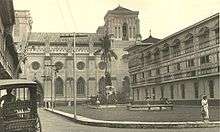
Education played a major role in the socio-economic transformation of the archipelago. The oldest universities, colleges, and vocational schools and the first modern public education system in Asia were all created during the Spanish colonial period, and by the time Spain was replaced by the United States as the colonial power, Filipinos were among the most educated subjects in all of Asia.[142] The Jesuits founded the Colegio de Manila in 1590, which later became the Universidad de San Ignacio, a royal and pontifical university. They also founded the Colegio de San Ildefonso on August 1, 1595. After the expulsion of the Society of Jesus in 1768, the management of the Jesuit schools passed to other parties. On April 28, 1611, through the initiative of Bishop Miguel de Benavides, the University of Santo Tomas was founded in Manila. The Jesuits also founded the Colegio de San José (1601) and took over the Escuela Municipal, later to be called the Ateneo de Manila University (1859). All institutions offered courses included not only religious topics but also science subjects such as physics, chemistry, natural history and mathematics. The University of Santo Tomás, for example, started by teaching theology, philosophy and humanities and during the 18th century, the Faculty of Jurisprudence and Canonical Law, together with the schools of medicine and pharmacy were opened.
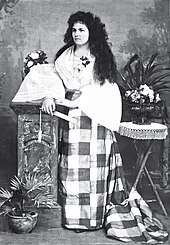
Outside the tertiary institutions, the efforts of missionaries were in no way limited to religious instruction but also geared towards promoting social and economic advancement of the islands. They cultivated into the natives their innate taste for music and taught Spanish language to children.[143] They also introduced advances in rice agriculture, brought from America maize and cocoa and developed the farming of indigo, coffee and sugar cane. The only commercial plant introduced by a government agency was the plant of tobacco. Church and state were inseparably linked in Spanish policy, with the state assuming responsibility for religious establishments.[144] One of Spain's objectives in colonizing the Philippines was the conversion of the local population to Roman Catholicism. The work of conversion was facilitated by the disunity and insignificance of other organized religions, except for Islam, which was still predominant in the southwest.[144] The pageantry of the church had a wide appeal, reinforced by the incorporation of indigenous social customs into religious observances. The eventual outcome was a new Roman Catholic majority, from which the Muslims of western Mindanao and the upland tribal and animistic peoples of Luzon remained detached and alienated from (Ethnic groups such as the Ifugaos of the Cordillera region and the Mangyans of Mindoro).
At the lower levels of administration, the Spanish built on traditional village organization by co-opting local leaders. This system of indirect rule helped create an indigenous upper class, called the principalía, who had local wealth, high status, and other privileges. This perpetuated an oligarchic system of local control. Among the most significant changes under Spanish rule was that the indigenous idea of communal use and ownership of land was replaced with the concept of private ownership and the conferring of titles on members of the principalía.[144]
Around 1608 William Adams, an English navigator contacted the interim governor of the Philippines, Rodrigo de Vivero y Velasco on behalf of Tokugawa Ieyasu, who wished to establish direct trade contacts with New Spain. Friendly letters were exchanged, officially starting relations between Japan and New Spain. From 1565 to 1821, the Philippines was governed as a territory of the Viceroyalty of New Spain from Mexico, via the Royal Audiencia of Manila, and administered directly from Spain from 1821 after the Mexican revolution,[145] until 1898.
The Manila galleons which linked Manila to Acapulco traveled once or twice a year between the 16th and 19th centuries. The Spanish military fought off various indigenous revolts and several external colonial challenges, especially from the British, Chinese pirates, Dutch, and Portuguese. Roman Catholic missionaries converted most of the lowland inhabitants to Christianity and founded schools, universities, and hospitals. In 1863 a Spanish decree introduced education, establishing public schooling in Spanish.[146]

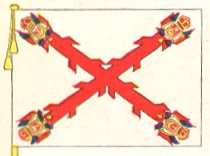
In 1646, a series of five naval actions known as the Battles of La Naval de Manila was fought between the forces of Spain and the Dutch Republic, as part of the Eighty Years' War. Although the Spanish forces consisted of just two Manila galleons and a galley with crews composed mainly of Filipino volunteers, against three separate Dutch squadrons, totaling eighteen ships, the Dutch squadrons were severely defeated in all fronts by the Spanish-Filipino forces, forcing the Dutch to abandon their plans for an invasion of the Philippines.
In 1687, Isaac Newton included an explicit reference to the Philippines in his classic Philosophiæ Naturalis Principia Mathematica by mentioning Leuconia, the ancient Ptolemaic name for the Philippines.[49]
Spanish rule during the 18th century
Colonial income derived mainly from entrepôt trade: The Manila Galleons sailing from the port of Manila to the port of Acapulco on the west coast of Mexico brought shipments of silver bullion, and minted coin that were exchanged for return cargoes of Asian, and Pacific products. A total of 110 Manila galleons set sail in the 250 years of the Manila-Acapulco galleon trade (1565 to 1815). There was no direct trade with Spain until 1766.[144]
The Philippines was never profitable as a colony during Spanish rule, and the long war against the Dutch from the West, in the 17th century together with the intermittent conflict with the Muslims in the South and combating Japanese Wokou piracy from the North nearly bankrupted the colonial treasury.[144] Furthermore, the state of near constant war caused a high death and desertion rate among the Mestizo, Mulatto and Indio (Native American) soldiers[147] sent from Mexico and Peru that were stationed in the Philippines.[148] The high death and desertion rate also applied to the native Filipino warriors conscripted by Spain, to fight in battles all across the archipelago. The repeated wars, lack of wages and near starvation were so intense, almost half of the soldiers sent from Latin America either died or fled to the countryside to live as vagabonds among the rebellious natives or escaped enslaved Indians (From India)[149] where they race-mixed through rape or prostitution, further blurring the racial caste system Spain tried hard to maintain.[150] These circumstances contributed to the increasing difficulty of governing the Philippines. The Royal Fiscal of Manila wrote a letter to King Charles III of Spain in which he advises to abandon the colony, but the religious orders opposed this since they considered the Philippines a launching pad for the conversion of the Far East.
The Philippines survived on an annual subsidy paid by the Spanish Crown and often procured from taxes and profits accrued by the Viceroyalty of New Spain (Mexico), and the 200-year-old fortifications at Manila had not been improved much since first built by the early Spanish colonizers.[151] This was one of the circumstances that made possible the brief British occupation of Manila between 1762 and 1764.
British invasion (1762–1764)
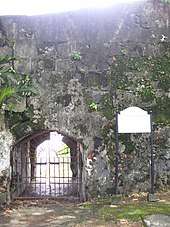
Britain declared war against Spain on January 4, 1762 and on September 24, 1762 a force of British Army regulars and British East India Company soldiers, supported by the ships and men of the East Indies Squadron of the British Royal Navy, sailed into Manila Bay from Madras, India.[152] Manila was besieged and fell to the British on October 4, 1762.
Outside of Manila, the Spanish leader Simón de Anda y Salazar organized a militia of 10,000 of mostly from Pampanga to resist British rule. Anda y Salazar established his headquarters first in Bulacan, then in Bacolor.[153] After a number of skirmishes and failed attempts to support uprisings, the British command admitted to the War Secretary in London that the Spanish were "in full possession of the country".[154] The occupation of Manila ended in April 1764 as agreed to in the peace negotiations for the Seven Years' War in Europe. The Spanish then persecuted the Binondo Chinese community for its role in aiding the British.[155] An unknown number of Indian soldiers known as sepoys, who came with the British, deserted and settled in nearby Cainta, Rizal, which explains the uniquely Indian features of generations of Cainta residents.[156]
Spanish rule in the second part of the 18th century
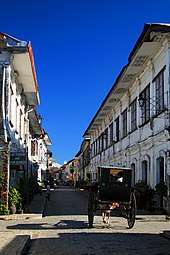

In 1766 direct communication was established with Spain and trade with Europe through a national ship based on Spain. In 1774, colonial officers from Bulacan, Tondo, Laguna Bay, and other areas surrounding Manila reported with consternation that discharged soldiers and deserters (From Mexico, Spain and Peru) who survived the previous British occupation, were providing indios military training for the weapons that had been disseminated all over the territory during the war.[157] Expeditions from Spain were administered since 1785 by the Real Compañía Filipina, which was granted a monopoly of trade between Spain and the islands that lasted until 1834, when the company was terminated by the Spanish crown due to poor management and financial losses.
In 1781, Governor-General José Basco y Vargas established the Economic Society of the Friends of the Country.[158] The Philippines was administered from the Viceroyalty of New Spain until the independence to Mexico in 1821 necessitated the direct rule from Spain of the Philippines from that year.
Spanish rule during the 19th century
The Philippines was included in the vast territory of the Kingdom of Spain, in the first constitution of Spain promulgated in Cadiz in 1812. It was never a colony as modern-day historical literature would say, but an overseas region in Asia (Spanish Constitution 1812). The Spanish Constitution of 1870 provides for the first autonomous community for "Archipelago Filipino" where all provinces in the Philippine Islands will be given the semi-independent home rule program.
During the 19th century Spain invested heavily in education and infrastructure. Through the Education Decree of December 20, 1863, Queen Isabella II of Spain decreed the establishment of a free public school system that used Spanish as the language of instruction, leading to increasing numbers of educated Filipinos.[159] Additionally, the opening of the Suez Canal in 1869 cut travel time to Spain, which facilitated the rise of the ilustrados, an enlightened class of Spanish-Filipinos that had been able to enroll in Spanish and European universities.
A great number of infrastructure projects were undertaken during the 19th century that put the Philippine economy and standard of living ahead of most of its Asian neighbors and even many European countries at that time. Among them were a railway system for Luzon, a tramcar network for Manila, and Asia's first steel suspension bridge Puente Claveria, later called Puente Colgante.[160]
On August 1, 1851 the Banco Español-Filipino de Isabel II was established to attend the needs of the rapid economic boom, that had greatly increased its pace since the 1800s as a result of a new economy based on a rational exploitation of the agricultural resources of the islands. The increase in textile fiber crops such as abacá, oil products derived from the coconut, indigo, that was growing in demand, etc., generated an increase in money supply that led to the creation of the bank. Banco Español-Filipino was also granted the power to print a Philippine-specific currency (the Philippine peso) for the first time (before 1851, many currencies were used, mostly the pieces of eight).
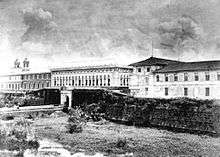
Spanish Manila was seen in the 19th century as a model of colonial governance that effectively put the interests of the original inhabitants of the islands before those of the colonial power. As John Crawfurd put it in its History of the Indian Archipelago, in all of Asia the "Philippines alone did improve in civilization, wealth, and populousness under the colonial rule" of a foreign power.[161] John Bowring, Governor General of British Hong Kong from 1856 to 1860, wrote after his trip to Manila:
"Credit is certainly due to Spain for having bettered the condition of a people who, though comparatively highly civilized, yet being continually distracted by petty wars, had sunk into a disordered and uncultivated state.
The inhabitants of these beautiful Islands upon the whole, may well be considered to have lived as comfortably during the last hundred years, protected from all external enemies and governed by mild laws vis-a-vis those from any other tropical country under native or European sway, owing in some measure, to the frequently discussed peculiar (Spanish) circumstances which protect the interests of the natives."[162]
In The Inhabitants of the Philippines, Frederick Henry Sawyer wrote:
.jpg)
"Until an inept bureaucracy was substituted for the old paternal rule, and the revenue quadrupled by increased taxation, the Filipinos were as happy a community as could be found in any colony. The population greatly multiplied; they lived in competence, if not in affluence; cultivation was extended, and the exports steadily increased. [...] Let us be just; what British, French, or Dutch colony, populated by natives can compare with the Philippines as they were until 1895?."[163]
The first official census in the Philippines was carried out in 1878. The colony's population as of December 31, 1877, was recorded at 5,567,685 persons.[164] This was followed by the 1887 census that yielded a count of 6,984,727,[165] while that of 1898 yielded 7,832,719 inhabitants.[166]
Spanish-Philippines then reached its peak when the Philippine-born Marcelo Azcárraga Palmero became Prime Minister of the Spanish Kingdom.[168][169] However, ideas of rebellion and independence began to spread through the islands. Many Latin-Americans[170] and Criollos were mostly officers in the army of Spanish Philippines. However, the onset of the Latin American wars of independence led to serious doubts of their loyalty, so they were soon replaced by Peninsular officers born in Spain. Criollo and Latino dissatisfaction against the Peninsulares resulted in the uprising of Andres Novales which was supported by local soldiers as well as former officers in the Spanish army of the Philippines who were from the now independent nations of Mexico, Colombia, Venezuela, Peru, Chile, Argentina and Costa Rica. The uprising was brutally suppressed but it foreshadowed the 1872 Cavite Mutiny that was a precursor to the Philippine Revolution.[171][172][173]
In the Americas; overseas Filipinos were involved in several Anti-colonial movements, Filomeno V. Aguilar Jr. in his paper: “Manilamen and seafaring: engaging the maritime world beyond the Spanish realm”, stated therein that Filipinos who were internationally called Manilamen were active in the navies and armies of the world even after the era of the Manila Galleons such as the case of the Argentine war of independence wherein an Argentinian of French descent, Hypolite Bouchard, who was a privateer for the Argentine army, when he laid siege to Monterey California, his second ship, the Santa Rosa which was captained by the American Peter Corney, had a multi-ethnic crew which included Filipinos.[174] Mercene, writer of the Book “Manila Men”, proposes that those Manilamen were recruited in San Blas, an alternative port to Acapulco Mexico where several Filipinos had settled during the Manila-Acapulco Galleon trade era.[175] Likewise, in Mexico, Filipinos like General Isidoro Montes de Oca had participated in the Mexican Revolutionary war against Spain too.[176] The recent participation of overseas Filipinos in Anti-Imperial wars in the Americas started even earlier when they assisted the United States in the defense of New Orleans during the War of 1812, when the United Kingdom attempted to Reconquer America.[177] Likewise, in this period, overseas Filipinos were also active in the Asia-Pacific especially in China. During the Taiping rebellion, Frederick Townsend Ward had a militia employing foreigners to quell the rebellion for the Qing government, at first he hired American and European adventurers but they proved unruly, while recruiting for better troops, he met his aide-de-camp, Vincente (Vicente?) Macanaya, who was twenty three years old in 1860 and was part of the large Filipino population then living in Shanghai, who “were handy on board ships and more than a little troublesome on land’, as Caleb Carr journalistically put it.[178] Smith, another writer about China also notes in his book: “Mercenaries and Mandarins” that Manilamen were ‘Reputed to be brave and fierce fighters’ and ‘were plentiful in Shanghai and always eager for action’. During this Taiping rebellion, by July 1860, Townsend Ward’s force of Manilamen ranging from one to two hundred mercenaries successfully assaulted Sung-Chiang Prefecture.[179] Thus, while the Philippines was slowly engendered with revolutionary fervour being supressed by Spain, overseas Filipinos have had an active role in the military and naval engagements of various nations in the Americas and Asia-Pacific.[180]
In 2006, the Civil Code of Spain provided that the acquisition of nationalities of Ibero-American countries, Andorra, the Philippines, Equatorial Guinea, Portugal and those of the Sephardic Jews originally from Spain, does not bear the loss of their Spanish nationalities of origin that paved the way for easier route of Spanish Nationality reacquisition by the people of the Philippines. A similar law in the Philippines was enacted later in 1963 that provides "Natural born citizens of the Philippines who acquired the citizenship of one of the Iberian countries, Ibero-American Countries and United Kingdom will not lose their natural born citizen status."
Philippine Revolution
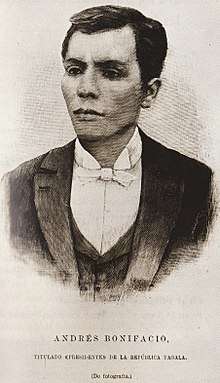
Revolutionary sentiments arose in 1872 after three Filipino priests, Mariano Gómez, José Burgos, and Jacinto Zamora, known as Gomburza, were accused of sedition by colonial authorities and executed by garote. This would inspire the Propaganda Movement in Spain, organized by Marcelo H. del Pilar, José Rizal, Graciano López Jaena, and Mariano Ponce, that clamored for adequate representation to the Spanish Cortes and later for independence. José Rizal, the most celebrated intellectual and radical ilustrado of the era, wrote the novels "Noli Me Tángere", and "El filibusterismo", which greatly inspired the movement for independence.[181] The Katipunan, a secret society whose primary purpose was that of overthrowing Spanish rule in the Philippines, was founded by Andrés Bonifacio who became its Supremo (leader).

The Philippine Revolution began in 1896. Rizal was wrongly implicated in the outbreak of the revolution and executed for treason in 1896. The Katipunan in Cavite split into two groups, Magdiwang, led by Mariano Álvarez (a relative of Bonifacio's by marriage), and Magdalo, led by Emilio Aguinaldo. Leadership conflicts between Bonifacio and Aguinaldo culminated in the execution or assassination of the former by the latter's soldiers. Aguinaldo agreed to a truce with the Pact of Biak-na-Bato and Aguinaldo and his fellow revolutionaries were exiled to Hong Kong. Not all the revolutionary generals complied with the agreement. One, General Francisco Makabulos, established a Central Executive Committee to serve as the interim government until a more suitable one was created. Armed conflicts resumed, this time coming from almost every province in Spanish-governed Philippines.

In 1898, as conflicts continued in the Philippines, the USS Maine, having been sent to Cuba because of U.S. concerns for the safety of its citizens during an ongoing Cuban revolution, exploded and sank in Havana harbor. This event precipitated the Spanish–American War.[182] After Commodore George Dewey defeated the Spanish squadron at Manila, a German squadron arrived in Manila and engaged in maneuvers which Dewey, seeing this as obstruction of his blockade, offered war—after which the Germans backed down.[183] The German Emperor expected an American defeat, with Spain left in a sufficiently weak position for the revolutionaries to capture Manila—leaving the Philippines ripe for German picking.[184]
The U.S. invited Aguinaldo to return to the Philippines in the hope he would rally Filipinos against the Spanish colonial government. Aguinaldo arrived on May 19, 1898, via transport provided by Dewey. On June 12, 1898, Aguinaldo declared the independence of the Philippines in Kawit, Cavite. Aguinaldo proclaimed a Revolutionary Government of the Philippines on June 23. By the time U.S. land forces arrived, the Filipinos had taken control of the entire island of Luzon except for Spanish capitol in the walled city of Intramuros. In the Battle of Manila, on August 13, 1898, the United States captured the city from the Spanish. This battle marked an end of Filipino-American collaboration, as Filipino forces were prevented from entering the captured city of Manila, an action deeply resented by the Filipinos.[185]
The First Philippine Republic (1899-1901)
On January 23, 1899, the First Philippine Republic was proclaimed under Asia's first democratic constitution, with Aguinaldo as its President.[181]
Spain and the United States had sent commissioners to Paris to draw up the terms of the Treaty of Paris to end the Spanish–American War. The Filipino representative, Felipe Agoncillo, had been excluded from sessions as Aguinaldo's government was not recognized by the family of nations.[185] Although there was substantial domestic opposition, the United States decided to annex the Philippines. In addition to Guam and Puerto Rico, Spain was forced in the negotiations to cede the Philippines to the U.S. in exchange for US$20,000,000.00.[186] U.S. President McKinley justified the annexation of the Philippines by saying that it was "a gift from the gods" and that since "they were unfit for self-government, ... there was nothing left for us to do but to take them all, and to educate the Filipinos, and uplift and civilize and Christianize them",[187][188] in spite of the Philippines having been already Christianized by the Spanish over the course of several centuries. The First Philippine Republic resisted the U.S. occupation, resulting in the Philippine–American War (1899–1913).
The estimated GDP per capita for the Philippines in 1900, the year Spain left, was $1,033.00. That made it the second-richest place in all of Asia, just a little behind Japan ($1,135.00), and far ahead of China ($652.00) and India ($625.00).[189]
American rule (1898–1946)
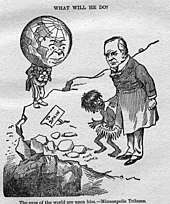
Filipinos initially saw their relationship with the United States as that of two nations joined in a common struggle against Spain.[190] However, the United States later distanced itself from the interests of the Filipino insurgents. Emilio Aguinaldo was unhappy that the United States would not commit to paper a statement of support for Philippine independence.[191] Relations deteriorated and tensions heightened as it became clear that the Americans were in the islands to stay.[191]
Philippine–American War
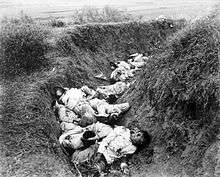
Hostilities broke out on February 4, 1899, after two American privates killed three Filipino soldiers as American forces launched a major attack in San Juan, a Manila suburb.[192] This began the Philippine–American War, which would cost far more money and take far more lives than the Spanish–American War.[181] Some 126,000 American soldiers would be committed to the conflict; 4,234 Americans died,[192] as did 12,000–20,000 Philippine Republican Army soldiers who were part of a nationwide guerrilla movement of at least 80,000 to 100,000 soldiers.[193]
The general population, caught between Americans and rebels, suffered significantly. At least 200,000 Filipino civilians lost their lives as an indirect result of the war mostly as a result of the cholera epidemic at the war's end that took between 150,000 and 200,000 lives.[194] Atrocities were committed by both sides.[192]
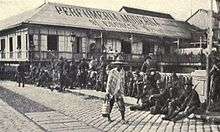
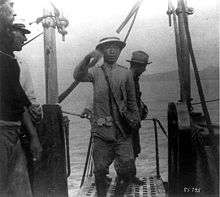
The poorly equipped Filipino troops were easily overpowered by American troops in open combat, but they were formidable opponents in guerrilla warfare.[192] Malolos, the revolutionary capital, was captured on March 31, 1899. Aguinaldo and his government escaped, however, establishing a new capital at San Isidro, Nueva Ecija. On June 5, 1899, Antonio Luna, Aguinaldo's most capable military commander, was killed by Aguinaldo's guards in an apparent assassination while visiting Cabanatuan, Nueva Ecija to meet with Aguinaldo.[195] With his best commander dead and his troops suffering continued defeats as American forces pushed into northern Luzon, Aguinaldo dissolved the regular army on November 13 and ordered the establishment of decentralized guerrilla commands in each of several military zones.[196] Another key general, Gregorio del Pilar, was killed on December 2, 1899 in the Battle of Tirad Pass—a rear guard action to delay the Americans while Aguinaldo made good his escape through the mountains.
Aguinaldo was captured at Palanan, Isabela on March 23, 1901 and was brought to Manila. Convinced of the futility of further resistance, he swore allegiance to the United States and issued a proclamation calling on his compatriots to lay down their arms, officially bringing an end to the war.[192] However, sporadic insurgent resistance continued in various parts of the Philippines, especially in the Muslim south, until 1913.[197]
.svg.png)
In 1900, President McKinley sent the Taft Commission, to the Philippines, with a mandate to legislate laws and re-engineer the political system.[198] On July 1, 1901, William Howard Taft, the head of the commission, was inaugurated as Civil Governor, with limited executive powers.[199] The authority of the Military Governor was continued in those areas where the insurrection persisted.[200] The Taft Commission passed laws to set up the fundamentals of the new government, including a judicial system, civil service, and local government. A Philippine Constabulary was organized to deal with the remnants of the insurgent movement and gradually assume the responsibilities of the United States Army.[201]
The Tagalog, Negros and Zamboanga Cantonal Republics
The Negros Republic, formed in the Visayas under Aniceto Lacson prior to the formation of the First Philippine Republic, welcomed the advancing American army as a friendly force. Two other insurgent republics were briefly formed during American administration: the Tagalog Republic in Luzon, under Macario Sakay,[202] and the Republic of Zamboanga in Mindanao under Mariano Arquiza.[203]
Insular Government (1901–1935)
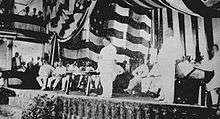
%2C_with_representatives_from_the_Philippine_Independence_Mission_(cropped).jpg)
The Philippine Organic Act was the basic law for the Insular Government, so called because civil administration was under the authority of the U.S. Bureau of Insular Affairs. This government saw its mission as one of tutelage, preparing the Philippines for eventual independence.[204] On July 4, 1902 the office of military governor was abolished and full executive power passed from Adna Chaffee, the last military governor, to Taft, who became the first U.S. Governor-General of the Philippines.[205] United States policies towards the Philippines shifted with changing administrations.[181] During the early years of territorial administration, the Americans were reluctant to delegate authority to the Filipinos, but an elected Philippine Assembly was inaugurated in 1907, as the lower house of a bicameral legislature, with the appointive Philippine Commission becoming the upper house.
Philippines was a major target for the progressive reformers. A 1907 report to Secretary of War Taft provided a summary of what the American civil administration had achieved. It included, in addition to the rapid building of a public school system based on English teaching, and boasted about such modernizing achievements as:
- steel and concrete wharves at the newly renovated Port of Manila; dredging the River Pasig,; streamlining of the Insular Government; accurate, intelligible accounting; the construction of a telegraph and cable communications network; the establishment of a postal savings bank; large-scale road-and bridge-building; impartial and incorrupt policing; well-financed civil engineering; the conservation of old Spanish architecture; large public parks; a bidding process for the right to build railways; Corporation law; and a coastal and geological survey.[206]
In 1903 the American reformers in the Philippines passed two major land acts designed to turn landless peasants into owners of their farms. By 1905 the law was clearly a failure. Reformers such as Taft believed landownership would turn unruly agrarians into loyal subjects. The social structure in rural Philippines was highly traditional and highly unequal. Drastic changes in land ownership posed a major challenge to local elites, who would not accept it, nor would their peasant clients. The American reformers blamed peasant resistance to landownership for the law's failure and argued that large plantations and sharecropping was the Philippines’ best path to development.[207]
Elite Filipina women played a major role in the reform movement, especially on health issues. They specialized on such urgent needs as infant care and maternal and child health, the distribution of pure milk and teaching new mothers about children's health. The most prominent organizations were the La Protección de la Infancia, and the National Federation of Women's Clubs.[208]
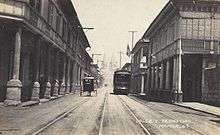
When Democrat Woodrow Wilson became U.S. president in 1913, new policies were launched designed to gradually lead to Philippine independence. In 1902 U.S. law established Filipinos citizenship in the Philippine Islands; unlike Hawaii in 1898 and Puerto Rico in 1918, they did not become citizens of the United States. The Jones Law of 1916 became the new basic law, promised eventual independence. It provide for the election of both houses of the legislature.
.jpg)
In socio-economic terms, the Philippines made solid progress in this period. Foreign trade had amounted to 62 million pesos in 1895, 13% of which was with the United States. By 1920, it had increased to 601 million pesos, 66% of which was with the United States.[209] A health care system was established which, by 1930, reduced the mortality rate from all causes, including various tropical diseases, to a level similar to that of the United States itself. The practices of slavery, piracy and headhunting were suppressed but not entirely extinguished. A new educational system was established with English as the medium of instruction, eventually becoming a lingua franca of the Islands. The 1920s saw alternating periods of cooperation and confrontation with American governors-general, depending on how intent the incumbent was on exercising his powers vis-à-vis the Philippine legislature. Members to the elected legislature lobbied for immediate and complete independence from the United States. Several independence missions were sent to Washington, D.C. A civil service was formed and was gradually taken over by Filipinos, who had effectively gained control by 1918.
Philippine politics during the American territorial era was dominated by the Nacionalista Party, which was founded in 1907. Although the party's platform called for "immediate independence", their policy toward the Americans was highly accommodating.[210] Within the political establishment, the call for independence was spearheaded by Manuel L. Quezon, who served continuously as Senate president from 1916 until 1935.
World War I gave the Philippines the opportunity to pledge assistance to the US war effort. This took the form of an offer to supply a division of troops, as well as providing funding for the construction of two warships. A locally recruited national guard was created and significant numbers of Filipinos volunteered for service in the US Navy and army.[211]
Frank Murphy was the last Governor-General of the Philippines (1933–35), and the first U.S. High Commissioner of the Philippines (1935–36). The change in form was more than symbolic: it was intended as a manifestation of the transition to independence.
Commonwealth
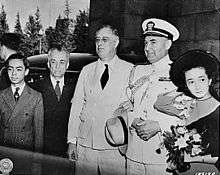
.jpg)
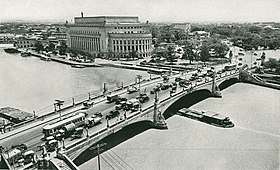
The Great Depression in the early thirties hastened the progress of the Philippines towards independence. In the United States it was mainly the sugar industry and labor unions that had a stake in loosening the U.S. ties to the Philippines since they could not compete with the Philippine cheap sugar (and other commodities) which could freely enter the U.S. market. Therefore, they agitated in favor of granting independence to the Philippines so that its cheap products and labor could be shut out of the United States.[212] In 1933, the United States Congress passed the Hare–Hawes–Cutting Act as a Philippine Independence Act over President Herbert Hoover's veto.[213] Though the bill had been drafted with the aid of a commission from the Philippines, it was opposed by Philippine Senate President Manuel L. Quezon, partially because of provisions leaving the United States in control of naval bases. Under his influence, the Philippine legislature rejected the bill.[214] The following year, a revised act known as the Tydings–McDuffie Act was finally passed. The act provided for the establishment of the Commonwealth of the Philippines with transition to full independence after a ten-year period. The commonwealth would have its own constitution and be self-governing, though foreign policy would be the responsibility of the United States, and certain legislation required approval of the United States president.[214] The Act stipulated that the date of independence would be on July 4 following the tenth anniversary of the establishment of the Commonwealth.
A Constitutional Convention was convened in Manila on July 30, 1934. On February 8, 1935, the 1935 Constitution of the Republic of the Philippines was approved by the convention by a vote of 177 to 1. The constitution was approved by President Franklin D. Roosevelt on March 23, 1935 and ratified by popular vote on May 14, 1935.[215][216]
On September 17, 1935,[217] presidential elections were held. Candidates included former president Emilio Aguinaldo, the Iglesia Filipina Independiente leader Gregorio Aglipay, and others. Manuel L. Quezon and Sergio Osmeña of the Nacionalista Party were proclaimed the winners, winning the seats of president and vice-president, respectively.[218]
The Commonwealth Government was inaugurated on the morning of November 15, 1935, in ceremonies held on the steps of the Legislative Building in Manila. The event was attended by a crowd of around 300,000 people.[217] Under the Tydings–McDuffie Act this meant that the date of full independence for the Philippines was set for July 4, 1946, a timetable which was followed after the passage of almost eleven very eventful years.
World War II and Japanese occupation
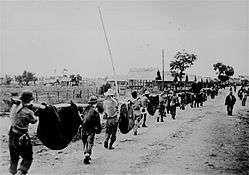
Military

Japan launched a surprise attack on the Clark Air Base in Pampanga on the morning of December 8, 1941, just ten hours after the attack on Pearl Harbor. Aerial bombardment was followed by landings of ground troops on Luzon. The defending Philippine and United States troops were under the command of General Douglas MacArthur. Under the pressure of superior numbers, the defending forces withdrew to the Bataan Peninsula and to the island of Corregidor at the entrance to Manila Bay.
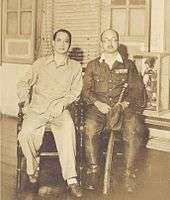
On January 2, 1942, General MacArthur declared the capital city, Manila, an open city to prevent its destruction.[219] The Philippine defense continued until the final surrender of United States-Philippine forces on the Bataan Peninsula in April 1942 and on Corregidor in May of the same year. Most of the 80,000 prisoners of war captured by the Japanese at Bataan were forced to undertake the infamous Bataan Death March to a prison camp 105 kilometers to the north. About 10,000 Filipinos and 1,200 Americans died before reaching their destination.[220] President Quezon and Osmeña had accompanied the troops to Corregidor and later left for the United States, where they set up a government in exile.[221] MacArthur was ordered to Australia, where he started to plan for a return to the Philippines.
The Japanese military authorities immediately began organizing a new government structure in the Philippines and established the Philippine Executive Commission. They initially organized a Council of State, through which they directed civil affairs until October 1943, when they declared the Philippines an independent republic. The Japanese-sponsored republic headed by President José P. Laurel proved to be unpopular to the pro-colonial Filipinos, but very popular to the pro-Asiatic independence Filipinos.
Japanese occupation of the Philippines was opposed by large-scale underground guerrilla activity. The American-aligned Philippine Army, as well as remnants of the U.S. Army Forces Far East,[222][223] continued to fight the Japanese and pro-Japanese paramilitary forces in a guerrilla war and was considered an auxiliary unit of the United States Army.[224] Their effectiveness was such that by the end of the war, Japan controlled only twelve of the forty-eight provinces.[225] One element of resistance in the Central Luzon area was furnished by the Hukbalahap, which armed some 30,000 people and extended their control over much of Luzon.[225]

The Philippines was the bloodiest theater of the war for the invading empire, with at least 498,600 Japanese troops killed in fighting the combined Filipino resistance and American soldiers, a larger amount of casualties compared to the second-placed theater, the entirety of China, which caused the Japanese about 455,700 casualties.[226] The occupation of the Philippines by Japan ended at the war's conclusion. At the eve of the liberation of the Philippines, the Allied forces and the Japanese Empire waged the largest naval battle in history, by gross tonnage in the Battle of Leyte Gulf.[229] The American army had been fighting the Philippines Campaign since October 1944, when MacArthur's Sixth United States Army landed on Leyte. Landings in other parts of the country had followed, and the Allies, with the Philippine Commonwealth troops, pushed toward Manila. However, fighting continued until Japan's formal surrender on September 2, 1945. Approximately 10,000 U.S. soldiers were missing in action in the Philippines when the war ended, more than in any other country in the Pacific or European Theaters. The Philippines suffered great loss of life and tremendous physical destruction, especially during the Battle of Manila. An estimated 1 million Filipinos had been killed, a large portion during the final months of the war, and Manila had been extensively damaged, mainly due to excessive use of artillery by the American forces.[225]
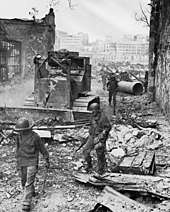
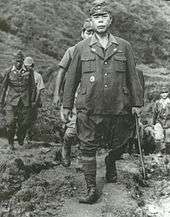
Home front
As in most occupied countries, crime, looting, corruption, and black markets were endemic. Japan in 1943 proposed independence on new terms, and some collaborators went along with the plan, but Japan was clearly losing the war and nothing became of it.[230]
With a view of building up the economic base of the Greater East Asia Co-Prosperity Sphere, the Japanese Army envisioned using the islands as a source of agricultural products needed by its industry. For example, Japan had a surplus of sugar from Taiwan but, a severe shortage of cotton, so they tried to grow cotton on sugar lands with disastrous results. They lacked the seeds, pesticides, and technical skills to grow cotton. Jobless farm workers flocked to the cities, where there was minimal relief and few jobs. The Japanese Army also tried using cane sugar for fuel, castor beans and copra for oil, derris for quinine, cotton for uniforms, and abaca (hemp) for rope. The plans were very difficult to implement in the face of limited skills, collapsed international markets, bad weather, and transportation shortages. The program was a failure that gave very little help to Japanese industry, and diverted resources needed for food production.

Living conditions were bad throughout the Philippines during the war. Transportation between the islands was difficult because of lack of fuel. Food was in very short supply, due to inflation.[231]
Postcolonial Philippines and the Third Republic (1946–1965)
The return of the Americans in spring 1945 was welcomed by nearly all the Filipinos, in sharp contrast to the situation in nearby Dutch East Indies. The collaborationist "Philippine Republic" set up by the Japanese under Jose P. Laurel, was highly unpopular, and the extreme destructiveness of the Japanese Army in Manila in its last days solidified Japan's image as a permanent target of hate. The pre-war Commonwealth system was reestablished under Sergio Osmeña, who became president in exile after President Quezon died in 1944. Osmeña was little-known and his Nacionalista Party was no longer such a dominant force. Osmeña supporters challenged the legitimacy of Manuel Roxas who had served as secretary to Laurel. MacArthur testified to Roxas' patriotism and the collaborationist issue disappeared after Roxas was elected in 1946 on a platform calling for closer ties with the United States; adherence to the new United Nations; national reconstruction; relief for the masses; social justice for the working class; the maintenance of peace and order; the preservation of individual rights and liberties of the citizenry; and honesty and efficiency of government.[232] The United States Congress passed a series of programs to help rehabilitation, including $2 billion over five years for war damages and rehabilitation, and a new tariff law that provided for a 20-year transition from free trade to a low tariff with the United States. Washington also demanded that Americans would have equal rights with Filipinos in business activities, a special treatment that was resented. In 1947 the United States secured an agreement that it would keep its major military and naval bases. On the whole the transition to independence, achieved in 1946, was mostly peaceful and highly successful, despite the extreme difficulties caused by massive war damages.[233] The special relationship with the United States remained the dominant feature until sharp criticism arose in the 1960s.[234]
Administration of Manuel Roxas (1946–1948)
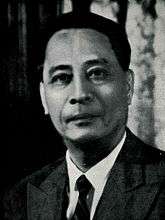
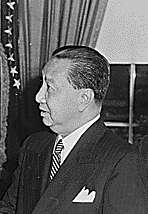
Elections were held in April 1946, with Manuel Roxas becoming the first president of the independent Republic of the Philippines. The United States ceded its sovereignty over the Philippines on July 4, 1946, as scheduled.[181][235] However, the Philippine economy remained highly dependent on United States markets—more dependent, according to United States high commissioner Paul McNutt, than any single U.S. state was dependent on the rest of the country.[236] The Philippine Trade Act, passed as a precondition for receiving war rehabilitation grants from the United States,[237] exacerbated the dependency with provisions further tying the economies of the two countries. A military assistance pact was signed in 1947 granting the United States a 99-year lease on designated military bases in the country.
Administration of Elpidio Quirino (1948–1953)
.jpg)
The Roxas administration granted general amnesty to those who had collaborated with the Japanese in World War II, except for those who had committed violent crimes. Roxas died suddenly of a heart attack in April 1948, and the vice president, Elpidio Quirino, was elevated to the presidency. He ran for president in his own right in 1949, defeating José P. Laurel and winning a four-year term.
World War II had left the Philippines demoralized and severely damaged. The task of reconstruction was complicated by the activities of the Communist-supported Hukbalahap guerrillas (known as "Huks"), who had evolved into a violent resistance force against the new Philippine government. Government policy towards the Huks alternated between gestures of negotiation and harsh suppression. Secretary of Defense Ramon Magsaysay initiated a campaign to defeat the insurgents militarily and at the same time win popular support for the government. The Huk movement had waned in the early 1950s, finally ending with the unconditional surrender of Huk leader Luis Taruc in May 1954.
Administration of Ramon Magsaysay (1953–1957)
Supported by the United States, Magsaysay was elected president in 1953 on a populist platform. He promised sweeping economic reform, and made progress in land reform by promoting the resettlement of poor people in the Catholic north into traditionally Muslim areas. Though this relieved population pressure in the north, it heightened religious hostilities.[238] Nevertheless, he was extremely popular with the common people, and his death in an airplane crash in March 1957 dealt a serious blow to national morale.[239]
Administration of Carlos P. Garcia (1957–1961)

Carlos P. Garcia succeeded to the presidency after Magsaysay's death, and was elected to a four-year term in the election of November that same year. His administration emphasized the nationalist theme of "Filipino first", arguing that the Filipino people should be given the chances to improve the country's economy.[240] Garcia successfully negotiated for the United States' relinquishment of large military land reservations. However, his administration lost popularity on issues of government corruption as his term advanced.[241]
Administration of Diosdado Macapagal (1961–1965)
In the presidential elections held on November 14, 1961, Vice President Diosdado Macapagal defeated re-electionist President Carlos P. Garcia and Emmanuel Pelaez as a Vice President. President Macapagal changed the independence day of the Philippines from July 4 to June 12.
Land Reform Code
The Agricultural Land Reform Code (RA 3844) was a major Philippine land reform law enacted in 1963 under President Macapagal.[242]
The code declared that it was State policy
- To establish owner-cultivatorship and the economic family-size farm as the basis of Philippine agriculture and, as a consequence, divert landlord capital in agriculture to industrial development;
- To achieve a dignified existence for the small farmers free from pernicious institutional restraints and practices;
- To create a truly viable social and economic structure in agriculture conducive to greater productivity and higher farm incomes;
- To apply all labor laws equally and without discrimination to both industrial and agricultural wage earners;
- To provide a more vigorous and systematic land resettlement program and public land distribution; and
- To make the small farmers more independent, self-reliant and responsible citizens, and a source of genuine strength in our democratic society.
and, in pursuance of those policies, established the following
- An agricultural leasehold system to replace all existing share tenancy systems in agriculture;
- A declaration of rights for agricultural labor;
- An authority for the acquisition and equitable distribution of agricultural land;
- An institution to finance the acquisition and distribution of agricultural land;
- A machinery to extend credit and similar assistance to agriculture;
- A machinery to provide marketing, management, and other technical services to agriculture;
- A unified administration for formulating and implementing projects of land reform;
- An expanded program of land capability survey, classification, and registration; and
- A judicial system to decide issues arising under this Code and other related laws and regulations.
Maphilindo
Maphilindo was a proposed nonpolitical confederation of Malaya, the Philippines, and Indonesia. It was based on concepts developed during the Commonwealth government in the Philippines by Wenceslao Vinzons and by Eduardo L. Martelino in his 1959 book Someday, Malaysia".[243]
In July 1963, President Diosdado Macapagal of the Philippines convened a summit meeting in Manila. Maphilindo was proposed as a realization of José Rizal's dream of bringing together the Malay peoples. However, this was perceived as a tactic on the parts of Jakarta and Manila to delay or prevent the formation of the Federation of Malaysia. The plan failed when Indonesian President Sukarno adopted his plan of Konfrontasi with Malaysia.[244]
Marcos era

Macapagal ran for re-election in 1965, but was defeated by his former party-mate, Senate President Ferdinand Marcos, who had switched to the Nacionalista Party. Early in his presidency, Marcos initiated public works projects and intensified tax collection.[245] In a failed attempt to retake east Sabah, the Jabidah massacre, where Muslim Tausug Filipinos were killed by the Philippine Army, occurred under the authority of Marcos.[246] Due to his popularity among Christians, Marcos was re-elected president in 1969, becoming the first president of the Philippines to get a second term.[245] Crime and civil disobedience increased. The Communist Party of the Philippines formed the New People's Army and the Moro National Liberation Front continued to fight for an independent Muslim nation in Mindanao. An explosion which killed opposition lawmakers during the proclamation rally of the senatorial slate of the Liberal Party on August 21, 1971 led Marcos to suspend the writ of habeas corpus. Protests surged and the writ was restored on January 11, 1972.[247]
Martial law
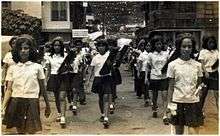
Amidst the rising wave of lawlessness and the conveniently timed threat of a looming Communist insurgency under his administration, as well as the growing popularity of the opposition, Marcos declared martial law on September 21, 1972 by virtue of Proclamation No. 1081 to stifle dissent.[247] Ruling by decree, Marcos curtailed press freedom and other civil liberties, abolished Congress, closed down major media establishments, ordered the arrest of opposition leaders and militant activists, including his staunchest critics: senators Benigno Aquino, Jr., Jovito Salonga and Jose Diokno.[248][247] Crime rates plunged dramatically after a curfew was implemented.[249] Many protesters, students, and political opponents were forced to go into exile, and a number were killed.[247][250]
A constitutional convention, which had been called for in 1970 to replace the colonial 1935 Constitution, continued the work of framing a new constitution after the declaration of martial law. The new constitution went into effect in early 1973, changing the form of government from presidential to parliamentary and allowing Marcos to stay in power beyond 1973. Marcos claimed that martial law was the prelude to creating a "New Society", which he would rule for more the two decades.[247] The economy during the 1970s was robust, due to previous engagements by various administrations. However, the economy suffered after incurring massive debt and downgrading prospects of the Philippines under martial rule, while the wife of the president, Imelda Marcos, lived in high society.[247][250]
The human rights abuses[251][252] particularly targeting political opponents, student activists, under the dictatorship particularly targeted political opponents, student activists,[253] journalists, religious workers, farmers, and others who fought back against the administration. Based on the documentation of Amnesty International, Task Force Detainees of the Philippines, and similar human rights monitoring entities,[254] the dictatorship was marked by 3,257 known extrajudicial killings,[254] 35,000 documented tortures, 77 'disappeared', and 70,000 incarcerations.[255][256]
Some 2,520 of the 3,257 murder victims were tortured and mutilated before their bodies were dumped in various places for the public to discover - a tactic meant to sow fear among the public,[255][257] which came to be known as "salvaging."[258] Some bodies were even cannibalized.[259]
Fourth Republic
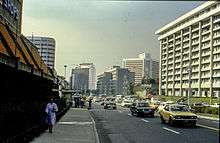
Marcos officially lifted martial law on January 17, 1981. However, he retained much of the government's power for arrest and detention. Corruption and nepotism as well as civil unrest contributed to a serious decline in economic growth and development under Marcos, whose own health faced obstacles due to lupus. The political opposition boycotted the 1981 presidential elections, which pitted Marcos against retired general Alejo Santos, in protest over his control over the results.[248] Marcos won by a margin of over 16 million votes, allowing him to have another six-year term under the new Constitution that his administration crafted.[250] Finance Minister Cesar Virata was eventually appointed to succeed Marcos as Prime Minister.[260]
In 1983, opposition leader Benigno Aquino, Jr. was assassinated at the Manila International Airport upon his return to the Philippines after a long period of exile. This coalesced popular dissatisfaction with Marcos and began a succession of events, including pressure from the United States, that culminated in a snap presidential election in February 1986.[250] The opposition united under Aquino's widow, Corazon Aquino. The official election canvasser, the Commission on Elections (Comelec), declared Marcos the winner of the election. However, there was a large discrepancy between the Comelec results and that of Namfrel, an accredited poll watcher. The allegedly fraudulent result was rejected local and international observers.[261] General Fidel Ramos and Defense Minister Juan Ponce Enrile withdrew their support for Marcos. A peaceful civilian-military uprising, now popularly called the People Power Revolution, forced Marcos into exile and installed Corazon Aquino as president on February 25, 1986. The administration of Marcos has been called by various sources as a conjugal dictatorship.[250][245]
Fifth Republic (1986–present)
Administration of Corazon Cojuangco Aquino (1986–1992)
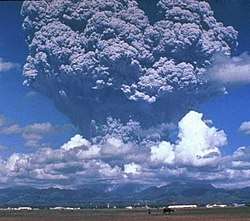
Corazon Aquino immediately formed a revolutionary government to normalize the situation, and provided for a transitional "Freedom Constitution".[262] A new permanent constitution was ratified and enacted in February 1987.[263]
The constitution crippled presidential power to declare martial law, proposed the creation of autonomous regions in the Cordilleras and Muslim Mindanao, and restored the presidential form of government and the bicameral Congress.[264]
Progress was made in revitalizing democratic institutions and respect for civil liberties, but Aquino's administration was also viewed as weak and fractious, and a return to full political stability and economic development was hampered by several attempted coups staged by disaffected members of the Philippine military.[265]
Economic growth was additionally hampered by a series of natural disasters, including the 1991 eruption of Mount Pinatubo that left 700 dead and 200,000 homeless.[266]
During the Aquino presidency, Manila witnessed six unsuccessful coup attempts, the most serious occurring in December 1989.[267]
In 1991, the Philippine Senate rejected a treaty that would have allowed a 10-year extension of the U.S. military bases in the country. The United States turned over Clark Air Base in Pampanga to the government in November, and Subic Bay Naval Base in Zambales in December 1992, ending almost a century of U.S. military presence in the Philippines.
Administration of Fidel Valdez Ramos (1992–1998)
In the 1992 elections, Defense Secretary Fidel V. Ramos, endorsed by Aquino, won the presidency with just 23.6% of the vote in a field of seven candidates. Early in his administration, Ramos declared "national reconciliation" his highest priority and worked at building a coalition to overcome the divisiveness of the Aquino years.[264]
He legalized the Communist Party and laid the groundwork for talks with communist insurgents, Muslim separatists, and military rebels, attempting to convince them to cease their armed activities against the government. In June 1994, Ramos signed into law a general conditional amnesty covering all rebel groups, and Philippine military and police personnel accused of crimes committed while fighting the insurgents.
In October 1995, the government signed an agreement bringing the military insurgency to an end. A peace agreement with the Moro National Liberation Front (MNLF), a major separatist group fighting for an independent homeland in Mindanao, was signed in 1996, ending the 24-year-old struggle. However, an MNLF splinter group, the Moro Islamic Liberation Front continued the armed struggle for an Islamic state.
Efforts by Ramos supporters to gain passage of an amendment that would allow him to run for a second term were met with large-scale protests, leading Ramos to declare he would not seek re-election.[268]
On his Presidency the death penalty was revived in the light of the rape-slay case of UPLB students Eileen Sarmienta and Allan Gomez in 1993 and the first person to be executed was Leo Echegaray in 1999.
Administration of Joseph Ejercito Estrada (1998–2001)
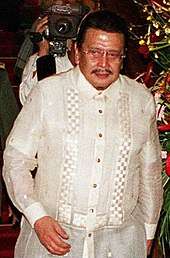
Joseph Estrada, a former movie actor who had served as Ramos' vice president, was elected president by a landslide victory in 1998. His election campaign pledged to help the poor and develop the country's agricultural sector. He enjoyed widespread popularity, particularly among the poor.[269] Estrada assumed office amid the Asian Financial Crisis. The economy did, however, recover from a low −0.6% growth in 1998 to a moderate growth of 3.4% by 1999.[270][271][272][273][274][275]
Like his predecessor there was a similar attempt to change the 1987 constitution. The process is termed as CONCORD or Constitutional Correction for Development. Unlike Charter change under Ramos and Arroyo the CONCORD proposal, according to its proponents, would only amend the 'restrictive' economic provisions of the constitution that is considered as impeding the entry of more foreign investments in the Philippines. However it was not successful in amending the constitution.
After the worsening secessionist movement in Mindanao in April 2000, President Estrada declared an "all-out-war" against the Moro Islamic Liberation Front (MILF).[276][277] The government later captured 46 MILF camps including the MILF's headquarters', Camp Abubakar.[276][278][279]
In October 2000, however, Estrada was accused of having accepted millions of pesos in payoffs from illegal gambling businesses. He was impeached by the House of Representatives, but his impeachment trial in the Senate broke down when the senate voted to block examination of the president's bank records. In response, massive street protests erupted demanding Estrada's resignation. Faced with street protests, cabinet resignations, and a withdrawal of support from the armed forces, Estrada was forced from office on January 20, 2001.
Administration of Gloria Macapagal-Arroyo (2001–2010)

Vice President Gloria Macapagal-Arroyo (the daughter of President Diosdado Macapagal) was sworn in as Estrada's successor on the day of his departure. Her accession to power was further legitimized by the mid-term congressional and local elections held four months later, when her coalition won an overwhelming victory.[280]
Arroyo's initial term in office was marked by fractious coalition politics as well as a military mutiny in Manila in July 2003 that led her to declare a month-long nationwide state of rebellion.[280] Later on in December 2002 she said would not run in May 10, 2004 presidential election, but she reversed herself in October 2003 and decided to join the race anyway.[280]
She was re-elected and sworn in for her own six-year term as president on June 30, 2004. In 2005, a tape of a wiretapped conversation surfaced bearing the voice of Arroyo apparently asking an election official if her margin of victory could be maintained.[281] The tape sparked protests calling for Arroyo's resignation.[281] Arroyo admitted to inappropriately speaking to an election official, but denied allegations of fraud and refused to step down.[281] Attempts to impeach the president failed later that year.
Halfway through her second term, Arroyo unsuccessfully attempted to push for an overhaul of the constitution to transform the present presidential-bicameral republic into a federal parliamentary-unicameral form of government, which critics describe would be a move that would allow her to stay in power as Prime Minister.[282]
Numerous other scandals (such as the Maguindanao massacre, wherein 58 people were killed, and the unsuccessful NBN-ZTE Broadband Deal) took place in the dawn of her administration. She formally ended her term as president in 2010 (wherein she was succeeded by Senator Benigno Aquino III) and ran for a seat in congress the same year (becoming the second president after Jose P. Laurel to run for lower office following the presidency).
Administration of Benigno Simeon Aquino III (2010–2016)
Benigno Aquino III began his presidency on June 30, 2010, the fifteenth President of the Philippines. He is a bachelor and the son of former Philippines president Corazon C. Aquino. His administration claimed to be focused on major reforms that would bring greater transparency, reduced poverty, reduced corruption, and a booming market which will give birth to a newly industrialized nation.
Just as with his predecessor, however, Aquino's administration has been marked with a mix of success and scandal since his inauguration, beginning with the 2010 Manila hostage crisis that caused deeply strained relations between Manila and Hong Kong for a time (affecting major events such as Wikimania 2013).
The Sultanate of Panay, founded in 2011, was recognized by the Lanao Advisory Council in 2012.
Tensions regarding Sabah due to the Sultanate of Sulu's claim gradually rose during the early years of his administration. Standoffs in Sabah between The Sultanate of Sulu's Royal Army and the Malaysian forces struck in 2013.
In 2012, the Framework Agreement on the Bangsamoro was signed to create the Bangsamoro Government in Mindanao. In response, the Bangsamoro Islamic Freedom Fighters (BIFF) was assembled by religious extremists with the goal of seceding from the Philippines.
The economy performed well at 7.2% GDP growth, the second fastest in Asia.
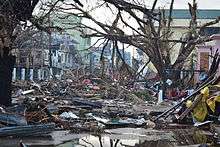
In 2013, Typhoon Haiyan (Yolanda) struck the country, leading to massive rehabilitation efforts by foreign world powers sending aid, inevitably devolving into chaos following the revelations that the administration and that the government had not been properly handing out the aid packages and preference for political maneuvering over the safety of the people, leading to mass deterioration of food and medical supplies.
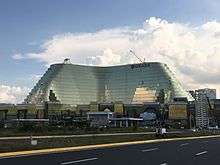
In 2014, the Comprehensive Agreement on the Bangsamoro was finally signed after 17 years of negotiation with the Moro Islamic Liberation Front (MILF), a move that is expected to bring peace in Mindanao and the Sulu.
On April 28, 2014, when United States President Barack Obama visited the Philippines, the Enhanced Defense Cooperation Agreement, between the United States of America and the Philippines, was signed.
From January 15 to 19, 2015, Pope Francis stayed in the Philippines for a series of publicity tours and paid visits to the victims of Typhoon Haiyan.
On January 25, 2015, 44 members of the Philippine National Police-Special Action Force (PNP-SAF) were killed during an encounter between MILF and BIFF in Mamasapano, Maguindanao putting efforts to pass the Bangsamoro Basic Law into law in an impasse.
Under his presidency, the Philippines has had controversial clashes with the People's Republic of China on a number of issues (such as the standoff in Scarborough Shoal in the South China Sea and the dispute over the Spratly islands). This resulted in the proceedings of the Philippines to file a sovereignty case against China in a global arbitration tribunal. Later on in 2014, the Aquino Administration then filed a memorial to the Arbitration Tribunal in The Hague which challenged Beijing's claim in the South China Sea after Chinese ships were accused of harassing a small Philippine vessel carrying goods for stationed military personnel in the South Thomas Shoal where an old Philippine ship had been stationed for many years.
Under his presidency, for aiming to enhance the educational system in the country, Aquino III signed the Enhanced Basic Education Act of 2013, commonly known as K–12 program on May 15, 2013.
On December 20, 2015, Pia Wurtzbach won the Miss Universe 2015, making her the third Filipino to win the Miss Universe title following Gloria Diaz in 1969 and Margarita Moran in 1973.
On January 12, 2016, the Philippine Supreme Court upheld the Enhanced Defense Cooperation Agreement paving the way for the return of United States Armed Forces bases into the country.
On March 23, 2016, Diwata-1 was launched to the International Space Station (ISS), becoming the country's first micro-satellite and the first satellite to be built and designed by Filipinos.
Administration of Rodrigo Roa Duterte (2016–present)
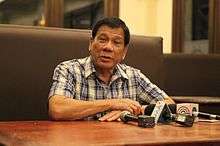
Davao City mayor Rodrigo Duterte of PDP–Laban won the 2016 presidential election, garnering 39.01% or 16,601,997 of the total votes, becoming the first Mindanaoan to become president. On the other hand, Camarines Sur 3rd District representative Leni Robredo won with the second narrowest margin in history, against Senator Bongbong Marcos.[283][284]
Duterte's presidency began following his inauguration on June 30, 2016 at the Rizal Ceremonial Hall of the Malacañang Palace in Manila, which was attended by more than 627 guests.[285]
On July 12, 2016, the Permanent Court of Arbitration ruled in favor of the Philippines in its case against China's claims in the South China Sea.[286]
Under his presidency, the government launched a 24-hour complaint office accessible to the public through a nationwide hotline, 8888, and changed the nationwide emergency telephone number from 117 to 911.[287][288] In addition, he has launched an intensified anti-drug campaign to fulfill a campaign promise of wiping out criminality in six months.[289] By August 2019, the death toll for the Philippine Drug War is 5,779.[290][291][292]
On November 8, 2016, the Supreme Court of the Philippines ruled in favor of the burial of the late president Ferdinand Marcos at the Libingan ng Mga Bayani, the country's official cemetery for heroes, provoking protests from various groups. The burial was done on November 18, 2016 in private. Later in the afternoon, the event was made public.[293]
On May 23, 2017, President Rodrigo Duterte signed Proclamation No. 216 declaring a 60-day martial law in Mindanao following clashes between government forces and the Maute group in Marawi.[294]
In a bid for attaining inclusive economic growth and the improvement quality of life in the country, Duterte launched DuterteNomics, with infrastructure development and industrialization being a significant part of its policy.[295] Part of it is the Build! Build! Build! Infrastructure Plan, which aims to usher in "a golden age of infrastructure" in the country. It includes the development of transport infrastructure such as railways, roads, airports, and seaports, as well as other infrastructure such as irrigation and flood control projects.[296][297]
Under his presidency, the Bangsamoro Organic Law was legislated into law.[298] It was later ratified after a plebiscite was held. The Bangsamoro transition period began, paving the way for the formal creation of the Bangsamoro ARMM.[299]
See also
- Ancient Filipino diet and health
- Archaeology of the Philippines
- Battles of Manila
- Battles of the Philippines
- Dambana
- Filipino nationalism
- Filipino Repatriation Act of 1935
- History of Asia
- History of Southeast Asia
- List of disasters in the Philippines
- List of Philippine historic sites
- List of Presidents of the Philippines
- List of sovereign state leaders in the Philippines
- Military history of the Philippines
- National hero of the Philippines
- Politics of the Philippines
- Resident Commissioner of the Philippines
- Sovereignty of the Philippines
- Suyat
- Timeline of Philippine history
- Timeline of Philippine sovereignty
Notes
- Scott, William Henry (1994). Barangay: Sixteenth Century Philippine Culture and Society. Quezon City: Ateneo de Manila University Press. ISBN 978-971-550-135-4.
- Junker, Laura Lee (1998). "Integrating History and Archaeology in the Study of Contact Period Philippine Chiefdoms". International Journal of Historical Archaeology. 2 (4): 291–320. doi:10.1023/A:1022611908759.
- Scott 1984.
- "Callao Man' Could Redraw Filipino History : Discovery News". DNews.
- "Pre-colonial Manila". Malacañang Presidential Museum and Library. Malacañang Presidential Museum and Library Araw ng Maynila Briefers. Malacañang Presidential Museum and Library, Presidential Communications Development and Strategic Planning Office. June 23, 2015. Archived from the original on March 9, 2016. Retrieved April 27, 2017.
- Jocano, F. Landa (2001). Filipino Prehistory: Rediscovering Precolonial Heritage. Quezon City: Punlad Research House, Inc. ISBN 978-971-622-006-3.
- Go, Bon Juan (2005). "Ma'I in Chinese Records - Mindoro or Bai? An Examination of a Historical Puzzle". Philippine Studies. Ateneo de Manila. 53 (1): 119–138. Archived from the original on October 21, 2013.
- Demetrio, Francisco R.; Cordero-Fernando, Gilda; Nakpil-Zialcita, Roberto B.; Feleo, Fernando (1991). The Soul Book: Introduction to Philippine Pagan Religion. GCF Books, Quezon City. ASIN B007FR4S8G.
- Thakur, Upendra (1986). Some Aspects of Asian History and Culture. Abhinav Publications. p. 4. ISBN 978-81-7017-207-9.
- Junker, Laura Lee (2000). Raiding, Trading, and Feasting: The Political Economy of Philippine Chiefdoms. Ateneo University Press. ISBN 978-971-550-347-1. Lay summary.
- Bisht, Bankoti & 2004, p. 69.
- "The Cultural Influences of India, Indonesia, China, Arabia, and Japan". philippinealmanac.com. Archived from the original on July 1, 2012.
- Bergreen, Laurence (October 14, 2003). Over the Edge of the World: Magellan's Terrifying Circumnavigation of the Globe. William Morrow. ISBN 978-0-06-621173-2.CS1 maint: ref=harv (link)
- "Cebu". encyclopedia.com.
- Zaide 1994, p. 281
- "Earliest known hominin activity in the Philippines by 709 thousand years ago". May 2, 2018.
- Valmero, Anna (August 5, 2010). "Callao man could be 'oldest' human in Asia Pacific, says Filipino archaeologist". Yahoo! Southeast Asia, loqal.ph. Retrieved August 5, 2010.
- Severino, Howie G. (August 1, 2010). Researchers discover fossil of human older than Tabon Man Archived August 4, 2010, at the Wayback Machine. GMA News. Retrieved October 21, 2010.
- Morella, Cecil. (August 3, 2010). 'Callao Man' Could Redraw Filipino History. Agence France-Presse. Retrieved October 21, 2010 from Discovery News.
- "Archaeologists unearth 67,000-year-old human bone in Philippines". The Daily Telegraph.
- The Utrecht Faculty of Education. "The Philippines – The Philippines in earlier times – The First Inhabitants 40,000 years ago". Archived from the original on August 11, 2009. Retrieved November 7, 2009.
- Détroit, Florent; Mijares, Armand Salvador; Corny, Julien; Daver, Guillaume; Zanolli, Clément; Dizon, Eusebio; Robles, Emil; Grün, Rainer; Piper, Philip J. (2019). "A new species of Homo from the Late Pleistocene of the Philippines". Nature. 568 (7751): 181–186. doi:10.1038/s41586-019-1067-9. ISSN 1476-4687. PMID 30971845.
- Solheim, Wilhelm G., II. (2006). Archeology and Culture in Southeast Asia. University of the Philippines Press. pp. 57–139. ISBN 978-971-542-508-7.
- Solheim, Wilhelm G., II. (January 2006). Origins of the Filipinos and Their Languages (PDF). Archived from the original (PDF) on August 3, 2008. Retrieved August 27, 2009.
- Mijares, Armand Salvador B (2006). "The Early Austronesian Migration To Luzon: Perspectives From The Peñablanca Cave Sites". Bulletin of the Indo-Pacific Prehistory Association. 26: 72–78. doi:10.7152/bippa.v26i0.11995. Archived from the original on July 7, 2014.
- Scott 1984, p. 138. "Not one roof beam, not one grain of rice, not one pygmy Negrito bone has been recovered. Any theory which describes such details is therefore pure hypothesis and should be honestly presented as such."
- Solheim II, Wilhelm G. "The Filipinos and their Languages" (PDF). Archived from the original (PDF) on August 3, 2008. Retrieved August 27, 2009.
- Scott 1984, p. 52.
- Bellwood, Peter (2014). The Global Prehistory of Human Migration. p. 213.
- Goodenough, Ward Hunt (1996). Prehistoric Settlement of the Pacific, Volume 86, Part 5. American Philosophical Society. pp. 127–128.
- Goodenough, Ward Hunt (1996). Prehistoric Settlement of the Pacific, Volume 86, Part 5. American Philosophical Society. p. 52.
- "Bernice Pauahi Bishop Museum". Archived from the original on February 28, 2014.
- Sagart, Laurent. "The expansion of Setaria farmers in East Asia".
- Li, H; Huang, Y; Mustavich, LF; et al. (November 2007). "Y chromosomes of prehistoric people along the Yangtze River". Hum. Genet. 122 (3–4): 383–8. doi:10.1007/s00439-007-0407-2. PMID 17657509.
- Ko, Albert Min-Shan; Chen, Chung-Yu; Fu, Qiaomei; Delfin, Frederick; Li, Mingkun; Chiu, Hung-Lin; Stoneking, Mark; Ko, Ying-Chin (March 6, 2014). "Early Austronesians: Into and Out Of Taiwan". The American Journal of Human Genetics. 94 (3): 426–436. doi:10.1016/j.ajhg.2014.02.003. PMID 24607387 – via www.cell.com.
- Scott 1984, p. 17.
- Bellwood, Peter (2011). Pathos of Origin. pp. 31–41.
- Hsiao-Chun, Hung (2007). Ancient jades map 3,000 years of prehistoric exchange in Southeast Asia.
- Legarda, Benito, Jr. (2001). "Cultural Landmarks and their Interactions with Economic Factors in the Second Millennium in the Philippines". Kinaadman (Wisdom) A Journal of the Southern Philippines. 23: 40.CS1 maint: multiple names: authors list (link) CS1 maint: ref=harv (link)
- Munoz, Paul Michael (2006). Early kingdoms of the Indonesian archipelago and the Malay peninsula. p. 45.
- Glover, Ian; Bellwood, Peter, eds. (2004). Southeast Asia: From Prehistory to History. Psychology Press. pp. 36, 157. ISBN 978-0-415-29777-6.
- The Philippines and India – Dhirendra Nath Roy, Manila 1929 and India and The World – By Buddha Prakash p. 119–120.
- Father Gabriel Casal & Regalado Trota Jose, Jr., Eric S. Casino, George R. Ellis, Wilhelm G. Solheim II, The People and Art of the Philippines, printed by the Museum of Cultural History, UCLA (1981)
- Bellwood, Peter, Hsiao-Chun Hung, and Yoshiyuki Iizuka. "Taiwan Jade in the Philippines: 3,000 Years of Trade and Long-distance Interaction." Paths of Origins: The Austronesian Heritage in the Collections of the National Museum of the Philippines, the Museum Nasional Indonesia, and the Netherlands Rijksmuseum voor Volkenkunde (2011): 31–41.
- Solheim, William (1969). "Prehistoric Archaeology in Eastern Mainland Southeast Asia and the Philippines". Asian Perspectives. 3: 97–108. hdl:10125/19126.
- Miksic, John N. (2003). Earthenware in Southeast Asia: Proceedings of the Singapore Symposium on Premodern Southeast Asian Earthenwares. Singapore: Singapore University Press, National University of Singapore.
- Philippine Journal of Linguistics – 23 – p. 67
- The Earth and Its Peoples: A Global History by Richard Bulliet, Pamela Crossley, Daniel Headrick, Steven Hirsch, Lyman Johnson p.186
- Mathematical Ideas in Early Philippine Society
- Philippine History by Maria Christine N. Halili. "Chapter 3: Precolonial Philippines" (Published by Rex Bookstore; Manila, Sampaloc St. Year 2004)
- Volume 5 of A study of the Eastern and Western Oceans (Japanese: 東西洋考) mentions that Luzon first sent tribute to Yongle Emperor in 1406.
- "Akeanon Online – Aton Guid Ra! – Aklan History Part 3 – Confederation of Madyaas". Akeanon.com. March 27, 2008. Retrieved January 2, 2010.
- "Katutubo, Muslim, Kristyano". Salazar at Mendoza-Urban. 1985.
- Munoz 2006, p. 171.
- Background Note: Brunei Darussalam, U.S. State Department.
- "Introduction". Mangyan Heritage Center. Archived from the original on February 13, 2008. Retrieved November 15, 2010.
- Scott 1985, p. 104
- The Report: The Philippines 2012. Oxford Business Group. 2012. p. 11. ISBN 978-1-907065-56-9.
- Woods, Damon L. (2006). The Philippines: A Global Studies Handbook. ABC-CLIO. p. 44. ISBN 978-1-85109-675-6.
- Scott, William Henry (1989). "Filipinos in China in 1500" (PDF). China Studies Program. De la Salle University. p. 8. Archived from the original (PDF) on September 23, 2015. Retrieved September 25, 2015.
- Manansala, Paul Kekai (November 23, 2005). "Quests of the Dragon and Bird Clan: Glossary: Luções".
- Scott, William Henry (1989). "Filipinos in China in 1500" (PDF). China Studies Program. De la Salle University. p. 8. Archived from the original (PDF) on July 24, 2015. Retrieved April 17, 2015.
- Sals, Florent Joseph (2005). The history of Agoo : 1578-2005. La Union: Limbagan Printhouse. p. 80.
- Ibn Battuta, The Travels of Ibn Baṭṭūṭa, A.D. 1325–1354, vol. 4, trans. H. A. R. Gibb and C. F. Beckingham (London: Hakluyt Society, 1994), pp. 884–5.
- "5 Things Why This Artifact May Change World History" By Kasaysayan Hunters. (2018) https://www.youtube.com/watch?v=VuRI30YeQj8
- Scott, William Henry (1994). Barangay. Manila Philippines: Ateneo de Manila University Press. p. 187.
- Scott 1984, p. 70.
- "South East Asia Pottery – Philippines". Seapots.com. Archived from the original on July 16, 2011. Retrieved October 27, 2011.
- Old Chinese Book Tells of the World 800 Years Ago; Chau-Ju-Kua's Chronicles of the Twelfth Century, Now First Translated, Give a "Description of Barbarous Peoples" Picked Up by This Noted Inspector of Foreign Trade and Descendant of Emperors.
- Scott 1984, p. 67.
- History of the Kingdom of Dapitan. Retrieved February 3, 2017.
- Jovito S. Abellana, "Bisaya Patronymesis Sri Visjaya" (Ms., Cebuano Studies Center, ca. 1960)
- "The Temples Of Bahal (Portibi): Traces of Vajranaya Buddhism in Sumatra". Wonderful Indonesia. Retrieved July 22, 2015.
- Strait of Malacca - World Oil Transit ChokepointsArchived 2014-11-22 at the Wayback Machine, Energy Information Administration, U.S. Department of Energy
- "saleeby 152-153"
- Maragtas by Pedro Alcantara Monteclaro
- Jovito Abellana, Aginid, Bayok sa Atong Tawarik, 1952
- Kinaadman. 2001. Volume 23. Xavier University Press. Page 34.
- Scott 1984, p. 59.
- "The Kingdom of Butuan". Philippine Gold: Treasures of Lost Kingdoms. Asia Society New York. Retrieved March 8, 2019.
- Lourdes Rausa-Gomez. "Sri Yijava and Madjapahit" (PDF). "Lourdes Rausa-Gomez cited Sir Stamford Raffles, himself citing the "Traditional History of Java" wherein he said that Manila and Sulu in the Philippines were part of Majapahapit, however she doubted the veracity of Stamford Raffles assertion due to the lack of archaeological evidence between Majapahit and the Philippines in her 1967 article. However, that article has been renderred outdated due to the discovery of the Laguna Copperplate Inscription in 1989 which proved links between Java and Manila, which makes her dismissal of the Raffles assertion null and the Raffles assertion feasible."
- History for Brunei Darussalam 2009, p. 44.
- Barski, p.46
- 100 Events That Shaped The Philippines (Adarna Book Services Inc. 1999 Published by National Centennial Commission) Page 72 "The Founding of the Sulu Sultanate"
- "The Maguindanao Sultanate", Moro National Liberation Front web site. "The Political and Religious History of the Bangsamoro People, condensed from the book Muslims in the Philippines by Dr. C. A. Majul." (archived from the original on 2003-01-26) Retrieved January 9, 2008.
- Palafox, Queenie. "The Sultan of the River". National Historical Commission. Retrieved March 16, 2013.
- Shinzō Hayase (2007). Mindanao Ethnohistory Beyond Nations: Maguindanao, Sangir, and Bagobo Societies in East Maritime Southeast Asia. University of Hawaii Press. p. 117. ISBN 978-971-550-511-6.
- Pusat Sejarah Brunei Archived April 15, 2015, at the Wayback Machine. Retrieved February 7, 2009.
- Santiago, Luciano P.R., The Houses of Lakandula, Matanda, and Soliman [1571–1898]: Genealogy and Group Identity, Philippine Quarterly of Culture and Society 18 [1990]
- Henson, Mariano A. 1965. The Province of Pampanga and Its Towns: A.D. 1300–1965. 4th ed. revised. Angeles City: By the author.
- Agoncillo 1990, p. 22.
- Lucoes warriors aided the Burmese king in his invasion of Siam in 1547 AD. At the same time, Lusung warriors fought alongside the Siamese king and faced the same elephant army of the Burmese king in the defence of the Siamese capital at Ayuthaya. SOURCE: Ibidem, page 195.
- The former sultan of Malacca decided to retake his city from the Portuguese with a fleet of ships from Lusung in 1525 AD. SOURCE: Barros, Joao de, Decada terciera de Asia de Ioano de Barros dos feitos que os Portugueses fezarao no descubrimiento dos mares e terras de Oriente [1628], Lisbon, 1777, courtesy of William Henry Scott, Barangay: Sixteenth-Century Philippine Culture and Society, Quezon City: Ateneo de Manila University Press, 1994, page 194.
- Pigafetta, Antonio (1969) [1524]. "First voyage round the world". Translated by J.A. Robertson. Manila: Filipiniana Book Guild. Cite journal requires
|journal=(help) - Pires, Tomé (1944). A suma oriental de Tomé Pires e o livro de Francisco Rodriguez: Leitura e notas de Armando Cortesão [1512 – 1515] (in Portuguese). Translated by Armando Cortesao. Cambridge: Hakluyt Society.
- Lach, Donald Frederick (1994). "Chapter 8: The Philippine Islands". Asia in the Making of Europe. Chicago: University of Chicago Press. ISBN 978-0-226-46732-0.
- Reid, Anthony (1995). "Continuity and Change in the Austronesian Transition to Islam and Christianity". In Peter Bellwood; James J. Fox; Darrell Tryon (eds.). The Austronesians: Historical and comparative perspectives. Canberra: Department of Anthropology, The Australian National University.
- Turnbull, C.M. (1977). A History of Singapore: 1819-1975. Kuala Lumpur: Oxford University Press. ISBN 978-0-19-580354-9.
- Antony, Robert J. Elusive Pirates, Pervasive Smugglers: Violence and Clandestine Trade in the Greater China Seas. Hong Kong: Hong Kong University Press, 2010. Print, 76.
- Junker, Laura L. Raiding, Trading, and Feasting: The Political Economy of Philippine Chiefdoms. Honolulu: University of Hawaiì Press, 1999.
- Wilkinson, R J. An Abridged Malay-English Dictionary (romanised). London: Macmillan and Co, 1948. Print, 291.
- Pigafetta, Antonio (1524). Relazione del primo viaggio intorno al mondo.
- Marivir Montebon, Retracing Our Roots – A Journey into Cebu's Pre-Colonial Past, p.15
- Celestino C. Macachor (2011). "Searching for Kali in the Indigenous Chronicles of Jovito Abellana". Rapid Journal. 10 (2). Archived from the original on July 3, 2012.
- Lacsamana 1990, p. 47
- Scott 1985, p. 51.
- & Kurlansky 1999, p. 64.
- Joaquin 1988.
- Alip 1964, p. 201,317.
- Annual report of the Secretary of War 1903, p. 379.
- McAmis 2002, p. 33.
- "Letter from Francisco de Sande to Felipe II, 1578". Archived from the original on October 14, 2014. Retrieved October 17, 2009.
- Frankham 2008, p. 278.
- Atiyah 2002, p. 71.
- Saunders 2002, pp. 54–60.
- Saunders 2002, p. 57.
- Fernando A. Santiago, Jr. "Isang Maikling Kasaysayan ng Pandacan, Maynila 1589–1898". Archived from the original on August 14, 2009. Retrieved July 18, 2008.
- Peter Borschberg (2015). Journal, Memorials and Letters of Cornelis Matelieff de Jonge. Security, Diplomacy and Commerce in 17th-Century Southeast Asia. Singapore: NUS Press. pp. 82, 84, 126, 421. Retrieved August 30, 2015.
- Truxillo, Charles A. (2012). Crusaders in the Far East: The Moro Wars in the Philippines in the Context of the Ibero-Islamic World War. Jain Publishing Company. p. 1. ISBN 978-0-89581-864-5.
- Peacock Gallop (2015) "From Anatolia to Aceh: Ottomans, Turks and Southeast Asia".
- Jiménez, David Sánchez (Fall 2010). "La hispanización y la identidad hispanaen Filipinas (1a parte)". Revista Filipina (in Spanish). XIV (3). ISSN 1496-4538.
- "Fortress of Empire, Rene Javellana, S. J. 1997".
- Barrows, David (2014). "A History of the Philippines". Guttenburg Free Online E-books. 1: 179.
Within the walls, there were some six hundred houses of a private nature, most of them built of stone and tile, and an equal number outside in the suburbs, or "arrabales," all occupied by Spaniards ("todos son vivienda y poblacion de los Españoles"). This gives some twelve hundred Spanish families or establishments, exclusive of the religious, who in Manila numbered at least one hundred and fifty, the garrison, at certain times, about four hundred trained Spanish soldiers who had seen service in Holland and the Low Countries, and the official classes.
- "Spanish Expeditions to the Philippines". PHILIPPINE-HISTORY.ORG. 2005.
- Herrington, Don. "West Coast Of The Island Of Luzon | Tourist Attractions". www.livinginthephilippines.com. Archived from the original on December 6, 2016. Retrieved February 2, 2017.
- Galaup "Travel Accounts" page 375.
- "Forced Migration in the Spanish Pacific World" By Eva Maria Mehl, page 235.
- Barrows, David (2014). "A History of the Philippines". Guttenburg Free Online E-books. 1: 229.
Reforms under General Arandía.—The demoralization and misery with which Obando's rule closed were relieved somewhat by the capable government of Arandía, who succeeded him. Arandía was one of the few men of talent, energy, and integrity who stood at the head of affairs in these islands during two centuries. He reformed the greatly disorganized military force, establishing what was known as the "Regiment of the King," made up very largely of Mexican soldiers [note: emphasis added]. He also formed a corps of artillerists composed of Filipinos. These were regular troops, who received from Arandía sufficient pay to enable them to live decently and like an army.
- "SECOND BOOK OF THE SECOND PART OF THE CONQUESTS OF THE FILIPINAS ISLANDS, AND CHRONICLE OF THE RELIGIOUS OF OUR FATHER, ST. AUGUSTINE" (Zamboanga City History) "He (Governor Don Sebastían Hurtado de Corcuera) brought a great reënforcements of soldiers, many of them from Peru, as he made his voyage to Acapulco from that kingdom."
- Quinze Ans de Voyage Autor de Monde Vol. II ( 1840) Archived 2014-10-09 at the Wayback Machine. Retrieved 2014-7-25 from Institute for Research of Iloilo Official Website.
- "The Philippine Archipelago" By Yves Boquet Page 262
- De la Torre, Visitacion (2006). The Ilocos Heritage. Makati City: Tower Book House. p. 2. ISBN 978-971-91030-9-7.
- The Unlucky Country: The Republic of the Philippines in the 21St Century By Duncan Alexander McKenzie (Page xii)
- Carol R. Ember; Melvin Ember; Ian A. Skoggard, eds. (2005). History. Encyclopedia of Diasporas: Immigrant and Refugee Cultures around the World, Volume 1. Springer.
- Stephanie Mawson, ‘Between Loyalty and Disobedience: The Limits of Spanish Domination in the Seventeenth Century Pacific’ (Univ. of Sydney M.Phil. thesis, 2014), appendix 3.
- "Japanese Christian". Philippines: Google map of Paco district of Manila, Philippines. Archived from the original on May 7, 2010. Cite journal requires
|journal=(help) - "Spanish Settlers in the Philippines (1571-1599) By Antonio Garcia-Abasalo" (PDF).
- Retana, "Relacion de las Encomiendas existentes en Filipinas el dia 31 de 1.591" Archivo del Bibliófilo Filipino IV, p 39–112
- Zamboangueño Chavacano: Philippine Spanish Creole or Filipinized Spanish Creole? By Tyron Judes D. Casumpang (Page 3)
- Barrows, David (2014). "A History of the Philippines". Guttenburg Free Online E-books. 1: 139.
Fourth.—In considering this Spanish conquest, we must understand that the islands were far more sparsely inhabited than they are to-day. The Bisayan islands, the rich Camarines, the island of Luzon, had, in Legaspi's time, only a small fraction of their present great populations. This population was not only small, but it was also extremely disunited. Not only were the great tribes separated by the differences of language, but, as we have already seen, each tiny community was practically independent, and the power of a dato very limited. There were no great princes, with large forces of fighting retainers whom they could call to arms, such as the Portuguese had encountered among the Malays south in the Moluccas.
- Spain (1680). Recopilación de las Leyes de Indias. Titulo Quince. De las Audiencias y Chancillerias Reales de las Indias. Madrid. Spanish-language facsimile of the original.
- Coleman 2009, pp. 17–59
- Antonio de Morga (1609). Sucesos de las Islas Filipinas. Fondo de Cultura. ISBN 978-0-521-01035-1.
- Dolan & 1991-4
- Shafer 1958
- "US Country Studies: Education in the Philippines". Countrystudies.us. Retrieved November 15, 2010.
- Letter from Fajardo to Felipe III From Manila, August 15 1620.(From the Spanish Archives of the Indies)("The infantry does not amount to two hundred men, in three companies. If these men were that number, and Spaniards, it would not be so bad; but, although I have not seen them, because they have not yet arrived here, I am told that they are, as at other times, for the most part boys, mestizos, and mulattoes, with some Indians (Native Americans). There is no little cause for regret in the great sums that reënforcements of such men waste for, and cost, your Majesty. I cannot see what betterment there will be until your Majesty shall provide it, since I do not think, that more can be done in Nueva Spaña, although the viceroy must be endeavoring to do so, as he is ordered.")
- Garcıa de los Arcos, “Grupos etnicos,” ´ 65–66
- The Diversity and Reach of the Manila Slave Market Page 36
- Tomás de Comyn, general manager of the Compañia Real de Filipinas, in 1810 estimated that out of a total population of 2,515,406, “the European Spaniards, and Spanish creoles and mestizos do not exceed 4,000 persons of both sexes and all ages, and the distinct castes or modifications known in America under the name of mulatto, quarteroons, etc., although found in the Philippine Islands, are generally confounded in the three classes of pure Indians, Chinese mestizos and Chinese.” In other words, the Mexicans who had arrived in the previous century had so intermingled with the local population that distinctions of origin had been forgotten by the 19th century. The Mexicans who came with Legázpi and aboard succeeding vessels had blended with the local residents so well that their country of origin had been erased from memory.
- Tracy 1995, pp. 12,55
- Tracy 1995, p. 9
- Tracy 1995, p. 58
- Backhouse, Thomas (1765). The Secretary at War to Mr. Secretary Conway. London: British Library. pp. v. 40.
- Raitisoja, Geni " Chinatown Manila: Oldest in the world" Archived April 2, 2011, at the Wayback Machine, Tradio86.com, July 8, 2006, accessed March 19, 2011.
- Fish 2003, p. 158
- "Eva Maria Mehl: Forced migration in the Spanish pacific world: From Mexico to the Philippines, 1765-1811" Page 100. From the original Spanish language source in the archives of Mexico: "CSIC ser. Consultas riel 208 leg.14 (1774)"
- Dolan & 1991-5
- Fundación Santa María (Madrid) 1994, p. 508
- Marciano R. De Borja (2005). Basques in the Philippines. University of Nevada Press. p. 132. ISBN 978-0-87417-590-5.
- John Crawfurd, History of the Indian Archipelago, (1820), page 445
- John Bowring, "Travels in the Philippines", p. 18, London, 1875
- Frederic H. Sawyer, "The inhabitants of the Philippines", Preface, London, 1900
- Population of the Philippines Census Years 1799 to 2007 Archived July 4, 2012, at the Wayback Machine. National Statistical Coordination Board,
- Jan Lahmeyer (1996). "The Philippines: historical demographical data of the whole country". Retrieved July 19, 2003.
- Voz de Galicia (1898). "CENSOS DE CUBA, PUERTO RICO, FILIPINAS Y ESPAÑA. ESTUDIO DE SU RELACION". Retrieved December 12, 2010.
- Sabastian, Stephen. Shaping the Western Hemisphere- Student Edition. Lulu.com. p. 128. ISBN 978-1-300-59653-0.
- He served as Prime Minister of the Spanish Monarchy in 1897, 1900-1901 and 1904-1905.[167]
- Joaquin, Nick (1990). Manila,My Manila. Vera-Reyes, Inc.
- “Officers in the army of the Philippines were almost totally composed of Americans,” observed the Spanish historian José Montero y Vidal. “They received in great disgust the arrival of peninsular officers as reinforcements, partly because they supposed they would be shoved aside in the promotions and partly because of racial antagonisms.”
- Nuguid, Nati. (1972). "The Cavite Mutiny". in Mary R. Tagle. 12 Events that Have Influenced Philippine History. [Manila]: National Media Production Center. Retrieved December 20, 2009 from StuartXchange Website.
- Joaquin, Nick. A Question of Heroes.
- Richardson, Jim (January 2006). "Andrés Bonifacio Letter to Julio Nakpil, April 24, 1897". Documents of the Katipunan. Archived from the original on January 15, 2013. Retrieved December 19, 2009.
- Delgado de Cantú, Gloria M. (2006). Historia de México. México, D. F.: Pearson Educación.
- Mercene, Manila men, p. 52.
- According to Ricardo Pinzon, these two Filipino soldiers—Francisco Mongoy and Isidoro Montes de Oca—were so distinguished in battle that they are regarded as folk heroes in Mexico. General Vicente Guerrero later became the first president of Mexico of African decent. See Floro L. Mercene, “Central America: Filipinos in Mexican History,” Ezilon Infobase, January 28, 2005, http://www.elizon.com/information/printer_476.html.
- Williams, Rudi (June 3, 2005). "DoD's Personnel Chief Gives Asian-Pacific American History Lesson". American Forces Press Service. U.S. Department of Defense. Archived from the original on June 15, 2007. Retrieved August 26, 2009.
- Caleb Carr, The devil soldier: the story of Frederick Townsend Ward, New York: Random House, 1992, p. 91.
- Smith, Mercenaries and mandarins, p. 29.
- For an exploration of Manilamen as mercenaries and filibusters in relation to the person and work of Jose´ Rizal, see Filomeno Aguilar Jr, ‘Filibustero, Rizal, and the Manilamen of the nineteenth century’, Philippine Studies, 59, 4, 2011, pp. 429–69.
- "Philippine History". DLSU-Manila. Archived from the original on August 22, 2006. Retrieved August 21, 2006.
- "The Destruction of USS Maine". U.S. Department of the Navy, Naval Historical Center. Archived from the original on August 18, 2007. Retrieved August 20, 2007.
- Wionzek 2000, p. xiv.
- Wionzek 2000, p. xvi.
- Lacsamana 1990, p. 126
- "Philippines – The Malolos Constitution and the Treaty of Paris". U.S. Library of Congress. Retrieved August 22, 2006.
- "President McKinley gives his reasons for the U.S. to keep the Philippines". Retrieved June 9, 2007.
- Woods 2005, p. 49
- NationMaster (2010). "GDP per capita in 1900 by country. Definition, graph and map". Retrieved December 12, 2010.
- Lacsamana 1990, p. 135
- Dolan & 1991-13
- Dolan & 1991-15
- Deady 2005, p. 55 (page 3 of the PDF)
- David Silbey (2008). A War of Frontier and Empire: The Philippine–American War, 1899–1902. Farrar, Straus and Giroux. pp. 200–01. ISBN 9780809096619.
- Agoncillo 1990, p. 222; Zaide 1994, p. 270.
- Linn 2000, p. 148.
- Agoncillo 1990, pp. 247–260, 294–297
- Escalante 2007, pp. 86–87.
- Taft 1908, p. 1
- Ellis 2008, p. 2143
- Escalante 2007, pp. 86–169 (ch. 5, Laying the Foundations of Colonial Rule)
- Kabigting Abad, Antonio (1955). General Macario L. Sakay: Was He a Bandit or a Patriot?. J. B. Feliciano and Sons Printers-Publishers.
- "History of The Republic of Zamboanga (May 1899 – March 1903)". Zamboanga City, Philippines: Zamboanga.com. July 18, 2009. Archived from the original on December 1, 2010. Retrieved August 13, 2010.
- Dolan & 1991-16
- Ellis 2008, p. 2163
- Andrew Roberts, A History of the English-Speaking Peoples Since 1900 (2008), p 26.
- Theresa Ventura (2016). "From Small Farms to Progressive Plantations: The Trajectory of Land Reform in the American Colonial Philippines, 1900–1916". Agricultural History. 90 (4): 459–483. doi:10.3098/ah.2016.090.4.459. JSTOR 10.3098/ah.2016.090.4.459.
- Mina Roces, "Filipino Elite Women and Public Health in the American Colonial Era, 1906–1940." Women's History Review 26#3 (2017): 477–502.
- Reyes, Jose (1923). Legislative history of America's economic policy toward the Philippines. Studies in history, economics and public law. 106 (2 ed.). Columbia University. pp. 192 of 232.
- Dolan & 1991-17
- Page 92, Volume 32 The Encyclopædia Britannica 1922 edition
- Goff, Richard; Moss, Walter G.; Terry, Janice; Upshur, Jiu-Hwa: The Twentieth Century: A Brief Global History, Boston: McGraw-Hill, 1998, pp. 212
- Agoncillo 1990, pp. 345–346
- Dolan & 1991-20
- Super Administrator. "Corpus Juris – 1935 Constitution". thecorpusjuris.com. Archived from the original on May 22, 2009.
- Zaide 1994, pp. 317–318 (archived from the original Archived May 22, 2009, at the Wayback Machine on 2009-05-22)
- "Franklin D. Roosevelt: Proclamation 2148 – Establishment of the Commonwealth of the Philippines". ucsb.edu.
- "Philippines, The period of U.S. influence". Encyclopædia Britannica Online. Retrieved February 10, 2007.
- Agoncillo 1990, p. 392
- Lacsamana 1990, p. 168
- Agoncillo 1990, p. 415
- Norling 2005.
- "The Intrepid Guerrillas of North Luzon". Defense Journal. 2002. Archived from the original on March 23, 2010. Retrieved May 21, 2009.
- "Map of known insurgent activity". Center of Military History. United States Army. Retrieved August 26, 2009.
- Dolan & 1991-21
- "Figures were compiled by the Relief Bureau of the Ministry of Health and Welfare in March 1964". Australia-Japan Research Project. Archived from the original on March 11, 2016. Retrieved March 10, 2016.
- Woodward, C. Vann (1947). The Battle for Leyte Gulf. New York: Macmillan.
- "LIEUTENANT RAMSEY'S WAR" by EDWIN PRICE RAMSEY and STEPHEN J. RIVELE.Published by Knightsbride publishing Co, Los Angeles, California
- [227][228]
- Dear and Foot, eds. Oxford Companion to World War II pp 877–79
- Ara, Satoshi (2008). "Food supply problem in Leyte, Philippines, during the Japanese Occupation (1942–44)". Journal of Southeast Asian Studies. 39 (1): 59–82. doi:10.1017/s0022463408000039.
- Bonifacio S. Salamanca,"Quezon, Osmena and Roxas and the American Military Presence in the Philippines." Philippine Studies 37.3 (1989): 301-316. online
- Paul H. Clyde, and Burton F. Beers, The Far East: A History of Western Impacts and Eastern Responses, 1830-1975 (1975) pp 476-77.
- Man Mohini Kaul, "Philippine Foreign Policy: Retrospect and Prospect." India Quarterly 33.1 (1977): 33-48.
- Treaty of General Relations between the Republic of the Philippines and the United States of America. Chanrobles law library. July 4, 1946. Retrieved November 30, 2007.
- Dolan & 1991-23
- "Balitang Beterano: Facts about Philippine Independence". Philippine Headline News Online. Retrieved August 21, 2006.
- Dolan & 1991-26
- "THE PHILIPPINES: Death of a Friend". Time. March 25, 1957.
- "Carlos Garcia: Unheralded nationalist". Philippine News Online. Archived from the original on October 26, 2006. Retrieved December 20, 2007.
- Lacsamana 1990, p. 184
- "Republic Act No. 3844 : The Agricultural Land Reform Code of the Philippines". August 8, 1963.
- Eduardo L. Martelino (1959). Someday Malaysia. Pageant Press.
- Greg Poulgrain (1998). The genesis of konfrontasi: Malaysia, Brunei, Indonesia, 1945–1965. Crawford House. ISBN 978-1-85065-513-8.
- Mijares 1976, p.
- "Jabidah and Merdeka: The inside story". September 13, 2015. Archived from the original on September 13, 2015.
- Francisco, Katerina. "Martial Law, the dark chapter in Philippine history". Rappler.
- Dolan & 1991-28
- Agoncillo 1990, pp. 576–577
- Javier, Research by Kristian. "A family affair | 31 years of amnesia". newslab.philstar.com.
- "Alfred McCoy, Dark Legacy: Human rights under the Marcos regime". Ateneo de Manila University. September 20, 1999.
- N., Abinales, P. (2005). State and society in the Philippines. Lanham, MD: Rowman & Littlefield Publishers. ISBN 978-0742510234. OCLC 57452454.
- "Gone too soon: 7 youth leaders killed under Martial Law". Rappler. Retrieved June 15, 2018.
- "3,257: Fact checking the Marcos killings, 1975-1985 - The Manila Times Online". www.manilatimes.net. April 12, 2016. Retrieved June 15, 2018.
- "Document". www.amnesty.org.
- Robles, Raissa (2016). Marcos Martial Law: Never Again. FILIPINOS FOR A BETTER PHILIPPINES , INC.
- W., McCoy, Alfred (2009). Policing America's empire : the United States, the Philippines, and the rise of the surveillance state. Madison, Wis.: University of Wisconsin Press. ISBN 9780299234133. OCLC 550642875.
- Cagurangan, Mar-Vic. "'Salvage' victims". The Guam Daily Post. Retrieved June 24, 2018.
- Mila D. Aguilar (October 3, 2015), So Why Samar?, retrieved June 18, 2018
- Celoza, Albert (1997). Ferdinand Marcos and the Philippines: the political economy of authoritarianism. Greenwood Publishing Group. p. 75. ISBN 978-0-275-94137-6.
- "Philippines - From Aquino's Assassination to People Power". U.S. Library of Congress. Retrieved August 22, 2006.
- Agoncillo 1990, p. 585
- Agoncillo 1990, p. 586
- "Background Notes: Philippines, November 1996". U.S. Department of State. Retrieved August 16, 2006.
- "Then & Now: Corazon Aquino". CNN. Retrieved August 16, 2006.
- "Pinatubo – Eruption Features". National Geophysical Data Center. Retrieved April 3, 2010.
- Riggs 1994, pp. 129–130 (footnote 18)
- "Showdown in Manila". Asiaweek. Archived from the original on November 10, 2006. Retrieved December 20, 2007.
- "Profile: Joseph Estrada". BBC News. October 26, 2007. Retrieved August 16, 2006.
- Antonio C. Abaya, GMA's successes, Manila Standard, January 17, 2008.
- Philippines' GDP grows 3.2 pc in 1999, GNP up 3.6 pc Archived November 17, 2011, at the Wayback Machine, Asian Economic News, January 31, 2000.
- Philippines' GDP up 4.5% in 2nd qtr, Asian Economic News, September 4, 2000.
- The Philippines: Sustaining Economic Growth Momentum In A Challenging Global Environment, Governor Amando M. Tetangco, Jr., Bangko Sentral ng Pilipinas, June 27, 2008. (WebCite archive of the original)
- Speech: THE PHILIPPINES: CONSOLIDATING ECONOMIC GROWTH, Governor Rafael Buenaventura, Bangko Sentral ng Pilipinas, March 13, 2000.
- Philippines : Recent Trends and Prospects, Asian Development Bank, 2001. (archived from the original on 2011-06-07)
- Speech of Former President Estrada on the GRP-MORO Conflict (September 18, 2008), Human development Network.
- In the Spotlight : Moro Islamic Liberation Front Archived September 9, 2012, at the Wayback Machine, Center for Defense Information Terrorism Project, February 15, 2002.
- Philippine Military Takes Moro Headquarters, People's Daily, July 10, 2000.
- AFP-MILF 2000 War in Mindanao Remembered Archived March 8, 2012, at the Wayback Machine (April 13, 2006), American Chronicle, May 13, 2009.
- "Country Profile: Philippines, March 2006" (PDF). U.S. Library of Congress. Retrieved August 22, 2006.
- "Gloria Macapagal Arroyo Talkasia Transcript". CNN. Retrieved July 29, 2006.
- Dalangin-Fernandez, Lira (July 20, 2006). "People's support for Charter change 'nowhere to go but up'". Philippine Daily Inquirer. Archived from the original on July 27, 2006. Retrieved July 27, 2006.
- "Duterte, Robredo win 2016 polls". ABS-CBN. May 27, 2016. Retrieved May 27, 2016.
- "Congress proclaims Duterte, Robredo as new President, VP; Rody a no-show". Inquirer.net. May 27, 2016. Retrieved May 27, 2016.
- Rañada, Pia (June 22, 2016). "Duterte inauguration guest list now has 627 names". Rappler. Retrieved June 30, 2016.
- Philips, T.; Holmes, O.; Bowcott, O. (July 12, 2016). "Philippines wins South China Sea case against China". The Guardian. Retrieved July 12, 2016.
- Corrales, Nestor (July 7, 2016). "Duterte administration to launch 24-hour hotline in August". Philippine Daily Inquirer. Retrieved July 9, 2016.
- "Dial 8888, 911: Gov't opens complaints, emergency hotlines". ABS CBN News. August 1, 2016. Retrieved August 1, 2016.
- "Duterte sworn in as Philippines president". Reuters. June 30, 2016. Retrieved August 24, 2016.
- "Between Duterte and a death squad, a Philippine mayor fights drug-war violence". Reuters. March 16, 2017.
- "#RealNumbersPH". Philippine Information Agency. Archived from the original on May 17, 2017. Retrieved May 22, 2017.
- "Cayetano: PH war on drugs exaggerated by fake news". ABS-CBN. May 5, 2017. Retrieved May 22, 2017.
- "Anti-Marcos protesters brave rains to condemn burial - The Manila Times Online". www.manilatimes.net.
- Esguerra, Anthony; Salaverria, Leila (May 23, 2017). "Duterte declares martial law in Mindanao". Philippine Daily Inquirer. Retrieved May 23, 2017.
- "Home". Build!. Retrieved June 28, 2017.
- "DuterteNomics unveiled". Presidential Communications Operations Office. April 19, 2017. Retrieved June 28, 2017.
- Vera, Ben O. de. "34 of 75 flagship infra projects to start in '18". Retrieved May 30, 2018.
- Unson, John (January 27, 2019). "Plebiscite in Mindanao: Will it be the last?". The Philippine Star. Retrieved January 27, 2019.
- Arguillas, Carolyn. "Bangsamoro law ratified; how soon can transition from ARMM to BARMM begin?". MindaNews. Retrieved January 26, 2019.
References
- Annual report of the Secretary of War. Washington GPO: US Army. 1903.
- History for Brunei Darussalam: Sharing our Past. Curriculum Development Department, Ministry of Education. 2009. ISBN 978-99917-2-372-3.
- Agoncillo, Teodoro A. (1990) [1960]. History of the Filipino People (8th ed.). Quezon City: Garotech Publishing. ISBN 978-971-8711-06-4.CS1 maint: ref=harv (link)
- Alip, Eufronio Melo (1964). Philippine History: Political, Social, Economic.CS1 maint: ref=harv (link)
- Atiyah, Jeremy (2002). Rough guide to Southeast Asia. Rough Guide. ISBN 978-1858288932.CS1 maint: ref=harv (link)
- Bisht, Narendra S.; Bankoti, T. S. (2004). Encyclopaedia of the South East Asian Ethnography. Global Vision Publishing Ho. ISBN 978-81-87746-96-6.CS1 maint: ref=harv (link)
- Brands, H. W. Bound to Empire: The United States and the Philippines (1992) excerpt
- Coleman, Ambrose (2009). The Firars in the Philippines. BiblioBazaar. ISBN 978-1-113-71989-8.CS1 maint: ref=harv (link)
- Deady, Timothy K. (2005). "Lessons from a Successful Counterinsurgency: The Philippines, 1899–1902" (PDF). Parameters. Carlisle, Pennsylvania: United States Army War College. 35 (1): 53–68. Archived from the original (PDF) on December 10, 2016. Retrieved September 30, 2018.CS1 maint: ref=harv (link)
- Dolan, Ronald E., ed. (1991). "Early History". Philippines: A Country Study. Washington: GPO for the Library of Congress. ISBN 978-0-8444-0748-7.
- Dolan, Ronald E., ed. (1991). "The Early Spanish". Philippines: A Country Study. Washington: GPO for the Library of Congress. ISBN 978-0-8444-0748-7.
- Dolan, Ronald E., ed. (1991). "The Decline of Spanish". Philippines: A Country Study. Washington: GPO for the Library of Congress. ISBN 978-0-8444-0748-7.
- Dolan, Ronald E., ed. (1991). "Spanish American War". Philippines: A Country Study. Washington: GPO for the Library of Congress. ISBN 978-0-8444-0748-7.
- Dolan, Ronald E., ed. (1991). "War of Resistance". Philippines: A Country Study. Washington: GPO for the Library of Congress. ISBN 978-0-8444-0748-7.
- Dolan, Ronald E., ed. (1991). "United States Rule". Philippines: A Country Study. Washington: GPO for the Library of Congress. ISBN 978-0-8444-0748-7.
- Dolan, Ronald E., ed. (1991). "A Collaborative Philippine Leadership". Philippines: A Country Study. Washington: GPO for the Library of Congress. ISBN 978-0-8444-0748-7.
- Dolan, Ronald E., ed. (1991). "Commonwealth Politics". Philippines: A Country Study. Washington: GPO for the Library of Congress. ISBN 978-0-8444-0748-7.
- Dolan, Ronald E., ed. (1991). "World War II". Philippines: A Country Study. Washington: GPO for the Library of Congress. ISBN 978-0-8444-0748-7.
- Dolan, Ronald E., ed. (1991). "Economic Relations with the United States". Philippines: A Country Study. Washington: GPO for the Library of Congress. ISBN 978-0-8444-0748-7.
- Dolan, Ronald E., ed. (1991). "The Magsaysay, Garcia, and Macapagal Administrations". Philippines: A Country Study. Washington: GPO for the Library of Congress. ISBN 978-0-8444-0748-7.
- Dolan, Ronald E., ed. (1991). "Marcos and the Road to Martial Law". Philippines: A Country Study. Washington: GPO for the Library of Congress. ISBN 978-0-8444-0748-7.
- Dolan, Ronald E., ed. (1991). "Proclamation 1081 and Martial Law". Philippines: A Country Study. Washington: GPO for the Library of Congress. ISBN 978-0-8444-0748-7.
- Dolan, Ronald E., ed. (1991). "From Aquino's Assassination to People Power". Philippines: A Country Study. Washington: GPO for the Library of Congress. ISBN 978-0-8444-0748-7.
- Duka, Cecilio D. (2008). Struggle for Freedom' 2008 Ed. Rex Bookstore, Inc. ISBN 978-971-23-5045-0.CS1 maint: ref=harv (link)
- Ellis, Edward S. (2008). Library of American History from the Discovery of America to the Present Time. READ BOOKS. ISBN 978-1-4437-7649-3.CS1 maint: ref=harv (link)
- Escalante, Rene R. (2007). The Bearer of Pax Americana: The Philippine Career of William H. Taft, 1900–1903. Quezon City, Philippines: New Day Publishers. ISBN 978-971-10-1166-6.CS1 maint: ref=harv (link)
- Riggs, Fred W. (1994). "Bureaucracy: A Profound Puzzle for Presidentialism". In Farazmand, Ali (ed.). Handbook of Bureaucracy. CRC Press. ISBN 978-0-8247-9182-7.CS1 maint: ref=harv (link)
- Fish, Shirley (2003). When Britain Ruled The Philippines 1762–1764. 1stBooks. ISBN 978-1-4107-1069-7.CS1 maint: ref=harv (link)
- Frankham, Steven (2008). Borneo. Footprint Handbooks. Footprint. ISBN 978-1906098148.CS1 maint: ref=harv (link)
- Fundación Santa María (Madrid) (1994). Historia de la educación en España y América: La educación en la España contemporánea : (1789–1975) (in Spanish). Ediciones Morata. ISBN 978-84-7112-378-7.CS1 maint: ref=harv (link)
- Joaquin, Nick (1988). Culture and history: occasional notes on the process of Philippine becoming. Solar Pub. Corp. ISBN 978-971-17-0633-3.CS1 maint: ref=harv (link)
- Karnow, Stanley. In Our Image: America's Empire in the Philippines (1990) excerpt
- Kurlansky, Mark (1999). The Basque history of the world. Walker. ISBN 978-0-8027-1349-0.CS1 maint: ref=harv (link)
- Lacsamana, Leodivico Cruz (1990). Philippine History and Government (Second ed.). Phoenix Publishing House, Inc. ISBN 978-971-06-1894-1.CS1 maint: ref=harv (link)
- Linn, Brian McAllister (2000). The Philippine War, 1899–1902. University Press of Kansas. ISBN 978-0-7006-1225-3.CS1 maint: ref=harv (link)
- McAmis, Robert Day (2002). Malay Muslims: The History and Challenge of Resurgent Islam in Southeast Asia. Eerdmans. ISBN 978-0802849458.CS1 maint: ref=harv (link)
- Munoz, Paul Michel (2006). Early Kingdoms of the Indonesian Archipelago and the Malay Peninsula. Editions Didier Millet. ISBN 978-981-4155-67-0.CS1 maint: ref=harv (link)
- Norling, Bernard (2005). The Intrepid Guerrillas of North Luzon. University Press of Kentucky. ISBN 978-0-8131-9134-8.CS1 maint: ref=harv (link)
- Saunders, Graham (2002). A History of Brunei. Routledge. ISBN 978-0700716982.CS1 maint: ref=harv (link)
- Schirmer, Daniel B.; Shalom, Stephen Rosskamm (1987). The Philippines Reader: A History of Colonialism, Neocolonialism, Dictatorship, and Resistance. South End Press. ISBN 978-0-89608-275-5.CS1 maint: ref=harv (link)
- Scott, William Henry (1984). Prehispanic source materials for the study of Philippine history. New Day Publishers. ISBN 978-971-10-0227-5.CS1 maint: ref=harv (link)
- Scott, William Henry (1985). Cracks in the parchment curtain and other essays in Philippine history. New Day Publishers. ISBN 978-971-10-0073-8.CS1 maint: ref=harv (link)
- Shafer, Robert Jones (1958). The economic societies in the Spanish world, 1763–1821. Syracuse University Press.CS1 maint: ref=harv (link)
- Taft, William (1908). Present Day Problems. Ayer Publishing. ISBN 978-0-8369-0922-7.CS1 maint: ref=harv (link)
- Tracy, Nicholas (1995). Manila Ransomed: The British Assault on Manila in the Seven Years War. University of Exeter Press. ISBN 978-0-85989-426-5.CS1 maint: ref=harv (link)
- Wionzek, Karl-Heinz (2000). "Germany, the Philippines, and the Spanish–American War: four accounts by officers of the Imperial German Navy". National Historical Institute. Cite journal requires
|journal=(help)CS1 maint: ref=harv (link) - Woods, Ayon kay Damon L. (2005). The Philippines. ABC-CLIO. ISBN 978-1-85109-675-6.CS1 maint: ref=harv (link)
- Zaide, Sonia M. (1994). The Philippines: A Unique Nation. All-Nations Publishing Co. ISBN 978-971-642-071-5.CS1 maint: ref=harv (link)
Further reading
- Abinales, Patricio N.; Amoroso, Donna J. (2005). State and Society in the Philippines. Rowman & Littlefield Publishers. ISBN 978-0-7425-6872-3.
- Columbia University Press (2001). "Philippines, The". Columbia Encyclopedia (6th ed.). Bartleby.com. Archived from the original on July 28, 2008.
- Barrows, David Prescott (1905). A History of the Philippines . Amer. Bk. Company.
- Blair, Emma Helen; Robertson, James Alexander, eds. (1903). 1582–1583. The Philippine Islands, 1493–1803. 5. Historical introduction and additional notes by Edward Gaylord Bourne. Cleveland, Ohio: Arthur H. Clark Company.
Explorations by early navigators, descriptions of the islands and their peoples, their history and records of the catholic missions, as related in contemporaneous books and manuscripts, showing the political, economic, commercial and religious conditions of those islands from their earliest relations with European nations.
- Blair and Robertson, The Philippine Islands, 1493–1898 (1903) vol 7 online
- vol 8 online
- vol 9 online
- vol 13 online
- vol 24 online
- vol 25 online
- vol 36 online
- vol 42 online
- Corpuz, O.D. (2005). Roots of the Filipino Nation. University of the Philippines Press. ISBN 978-971-542-461-5.
- Elliott, Charles Burke (1916). The Philippines : To the End of the Military Régime (PDF). The Bobbs-Merrill Company.
- Elliott, Charles Burke (1917). The Philippines: To the End of the Commission Government, a Study in Tropical Democracy (pdf). The Bobbs-Merrill Company.
- Foreman, John (1906). The Philippine Islands, A Political, Geographical, Ethnographical, Social and Commercial History of the Philippine Archipelago. Charles Scribner's Sons. (other formats available)
- Mijares, Primitivo (1976). The Conjugal Dictatorship of Ferdinand and Imelda Marcos. Union Square Publications.CS1 maint: ref=harv (link) Republished as Mijares, Primitivo (2017). The Conjugal Dictatorship of Ferdinand and Imelda Marcos. Ateneo de Manila University Press. ISBN 978-971-550-781-3.
- Millis, Walter (1931). The Martial Spirit. Houghton Mifflin Company. ISBN 978-0-929587-07-3.
- Kalaw, Maximo M. (1927). "Early Political Life in the Philippines". The development of Philippine politics. Oriental commercial. p. 1. Retrieved January 21, 2008.
- Nieva, Gregorio (September 28, 1921). "Now Is The Time To Solve The Philippine Problem: The View Of A Representative Filipino". The Outlook. Outlook Publishing Company, Inc. 129: 135–137. Retrieved July 30, 2009.CS1 maint: ref=harv (link)
- Scott, William Henry (1992). Looking for the Prehispanic Filipino: And Other Essays in Philippine History. New Day Publishers. ISBN 978-971-10-0524-5.
- Worcester, Dean Conant (1913). The Philippines: Past and Present. New York: The Macmillan company.
- Worcester, Dean Conant (1898). The Philippine Islands and Their People.
External links
| Wikimedia Commons has media related to History of the Philippines. |
- Official government portal of the Republic of the Philippines.
- National Historical Institute.
- The United States and its Territories 1870–1925: The Age of Imperialism.
- History of the Philippine Islands by Morga, Antonio de in 55 volumes, from Project Gutenberg. Translated into English, edited and annotated by E. H. Blair and J. A. Robertson. Volumes 1–14 and 15–25 indexed under Blair, Emma Helen.
- Philippine Society and Revolution (archived from the original on 2010-01-10).
- The European Heritage Library – Balancing Paradise and Pandemonium: Philippine Encounters with the rest of the World
- Filipiniana, The Premier Digital Library of the Philippines
- Philippine History
